There are moments while surfing the net that trigger memories of long ago popular knitting patterns. One such is the piano scarf, usually knit double bed. For a while, knit QR codes, or even bar codes were “the thing”. Decades ago, long before online converters and easily available information, there were a few articles on converting alphabets to binary codes for knitting. Far more recent versions with different interpretations: using ones and zeros for pattern, hand-knit https://knitty.com/ISSUEwinter06/PATTbinary.html 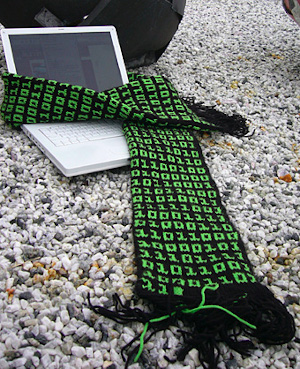 A collection of machine-knit versions https://knithacker.com/2017/03/sam-meechs- knitted-binary-scarves/
A collection of machine-knit versions https://knithacker.com/2017/03/sam-meechs- knitted-binary-scarves/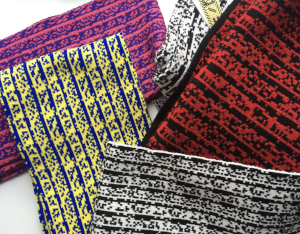 I prefer the more abstract to the literal interpretation using numbers, happen to have a 12 letter first name, and thought I would go for converting it. Because of the number of letters involved, the repeat would of necessity have to be a vertical one. I used 2 converters to double-check the result, noticing that when one of the letters repeats, the code for each of the 2 letters is slightly different. Of the many choices, I used these converters https://www.prepostseo.com/tool/text-to-binary-converter, and https://www.convertbinary.com/text-to-binary/
I prefer the more abstract to the literal interpretation using numbers, happen to have a 12 letter first name, and thought I would go for converting it. Because of the number of letters involved, the repeat would of necessity have to be a vertical one. I used 2 converters to double-check the result, noticing that when one of the letters repeats, the code for each of the 2 letters is slightly different. Of the many choices, I used these converters https://www.prepostseo.com/tool/text-to-binary-converter, and https://www.convertbinary.com/text-to-binary/
Each letter is converted to 8 digits, making results easily adaptable for punchcard use. 01000001 01101100 01100101 01110011 01110011 01100001 01101110 01100100 01110010 01101001 01101110 01100001. My spreadsheet in Numbers refused to allow me to enter the 0s at the start of each sequence, so the 0 has its own column, and in the larger chart, it is illustrated as a blank vertical row 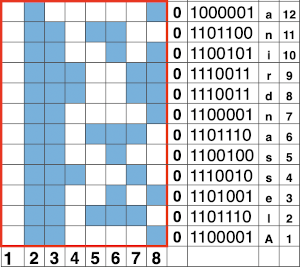 The problem if such repeats are used for fair isle knitting is that the results are likely to separate along those long vertical lines and to curl to the purl side even if blocked flat to start with. Converting the pattern for use on the double bed with any DBJ technique and backing is the better solution. My results, with letters from the bottom up
The problem if such repeats are used for fair isle knitting is that the results are likely to separate along those long vertical lines and to curl to the purl side even if blocked flat to start with. Converting the pattern for use on the double bed with any DBJ technique and backing is the better solution. My results, with letters from the bottom up 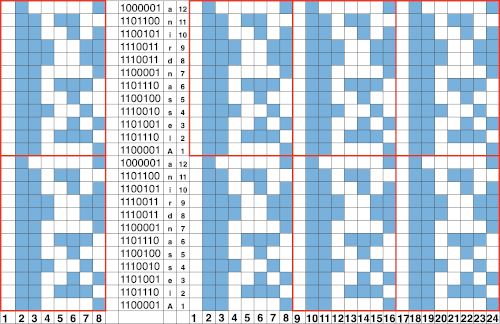 Programming the width of the number of needles to be used for the “scarf”, allows for the addition of a border stitch (or more) on either side. Start the base with and use the dark color for your first knit row from right to left in most of the automatic 2 color separations. Here is a tentative 72+1 stitch version
Programming the width of the number of needles to be used for the “scarf”, allows for the addition of a border stitch (or more) on either side. Start the base with and use the dark color for your first knit row from right to left in most of the automatic 2 color separations. Here is a tentative 72+1 stitch version 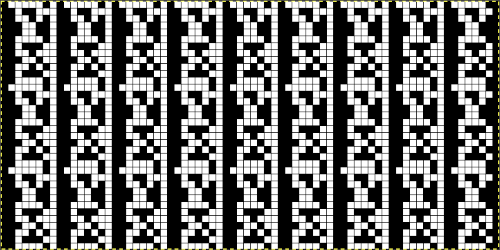 The related swatch, knit nearly 4 years later, forgetting that the 930 automatically mirrors text and motifs, so my repeat is mirrored horizontally 🙁
The related swatch, knit nearly 4 years later, forgetting that the 930 automatically mirrors text and motifs, so my repeat is mirrored horizontally 🙁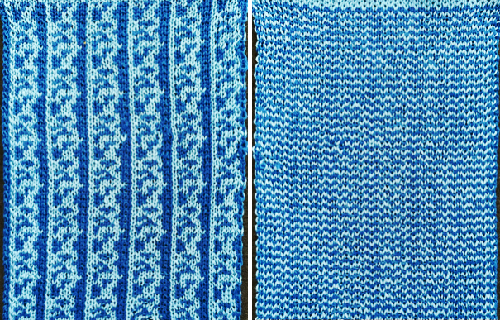 If numbers are your preference, with a bit of playing around digits may be adjusted in width and height
If numbers are your preference, with a bit of playing around digits may be adjusted in width and height  going a bit bolder, the 8 individual letters as numbers could repeat horizontally across each design row.
going a bit bolder, the 8 individual letters as numbers could repeat horizontally across each design row.  A repeat for the letter AX2 planned for the first segment of an 82 stitch wide scarf,
A repeat for the letter AX2 planned for the first segment of an 82 stitch wide scarf,  with the number of knit rows between each letter group started at 5. An attempt to visualize the final look using only the letter A.
with the number of knit rows between each letter group started at 5. An attempt to visualize the final look using only the letter A.
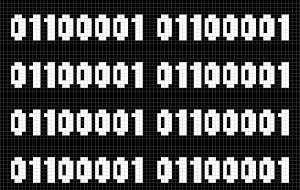 G carriages may be used to knit the same patterns in knit and purl stitch combinations.
G carriages may be used to knit the same patterns in knit and purl stitch combinations.
Automated shapes across rows of knitting using slip stitch only
WORK IN PROGRESS
Full automation of “held” shapes using slip stitch alone is possible, involves careful planning of the design repeat, an understanding of necessary sequences in “holding” techniques, and results in large, long repeats for recurring shapes.
The starting side for preselection rows varies depending on the design.
Pattern knitting is worked with both cam buttons set to slip, end needle selection must be canceled.
All stitches on the knitting bed must be cleared with each pass of the carriage from side to side.
As shapes grow, test periodically for any yarn loops accidentally caught on the gate pegs.
The overall downloaded program needs to include repeats planned for the number of stitches in work on the needle bed. This is the standard requirement for Ayab, on my 930 the default img2track programming is for a single motif.
If working on an odd number of needles, whether the needle selection is pushed to the right or left of center varies depending on the brand of machine used and changes if horizontal mirroring of the design is added.
It is helpful to begin with small, narrow repeats for practice. Assorted samples from previous posts:
a ruffle also using the garter bar 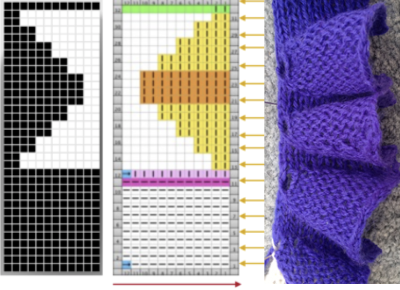 a couple of zig-zags
a couple of zig-zags  only one of many pleat variations that may be enlarged and planned for the width of the bed in knitting items such as sideways skirts
only one of many pleat variations that may be enlarged and planned for the width of the bed in knitting items such as sideways skirts  repeats planned for texture
repeats planned for texture 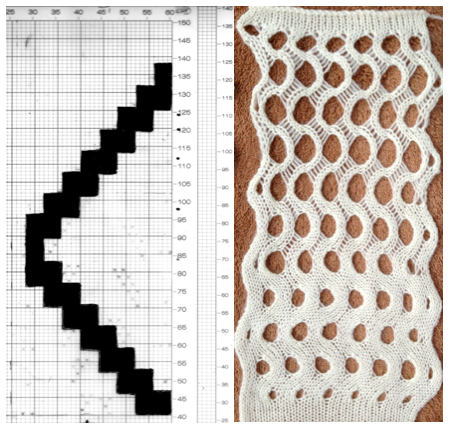 bumps and slits
bumps and slits 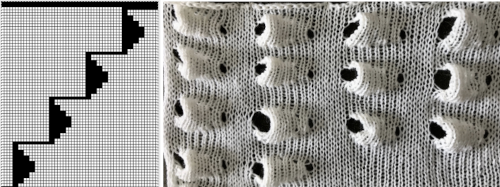 shell shapes
shell shapes  Testing the idea on a limited width with small intended shapes helps one iron out errors in logic or knitting sequences, I prefer to start with a colored chart, making it easier to follow movements of the yarn, carriages, and color changes
Testing the idea on a limited width with small intended shapes helps one iron out errors in logic or knitting sequences, I prefer to start with a colored chart, making it easier to follow movements of the yarn, carriages, and color changes 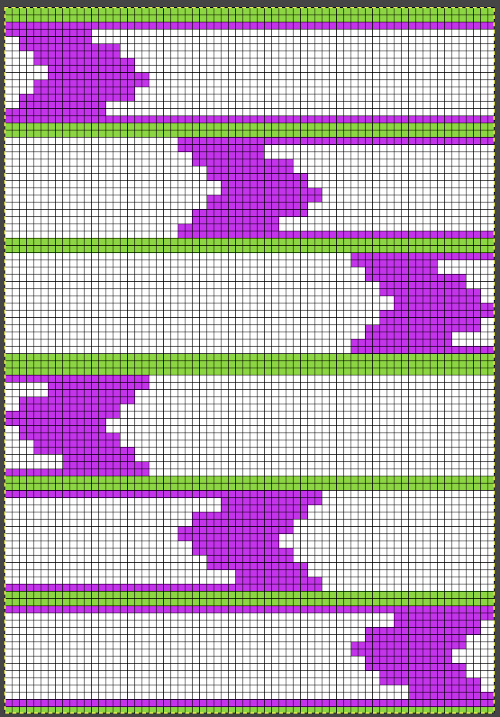 The chart was then loaded in Gimp, the Mode changed to bitmapped B/W, and the image then scaled to the final width of 74 X 96. For this exercise, I chose to keep the shapes equal distances apart (marked in green), mirrored the image on my 930 to produce the shapes in the same direction. In this instance, as is often encountered in lace knitting, an odd number of rows between repeat segments will allow for the carriage to start from the opposite side in order to reverse the direction of the shaps. The first preselection row may start from either side depending on whether the downloaded image is mirrored or not, whether by intention or automatically by the machine model’s auto settings. The default isolation in img2track is fine, ayab knitters are required to program the repeat in width to match the number of needles in use, so this would work for both
The chart was then loaded in Gimp, the Mode changed to bitmapped B/W, and the image then scaled to the final width of 74 X 96. For this exercise, I chose to keep the shapes equal distances apart (marked in green), mirrored the image on my 930 to produce the shapes in the same direction. In this instance, as is often encountered in lace knitting, an odd number of rows between repeat segments will allow for the carriage to start from the opposite side in order to reverse the direction of the shaps. The first preselection row may start from either side depending on whether the downloaded image is mirrored or not, whether by intention or automatically by the machine model’s auto settings. The default isolation in img2track is fine, ayab knitters are required to program the repeat in width to match the number of needles in use, so this would work for both  I did run into an operator problem: had managed to save the repeat so rather than being all B/W there was a single row of color at its base, which caused mispatterning only when that #1 design row was knit.
I did run into an operator problem: had managed to save the repeat so rather than being all B/W there was a single row of color at its base, which caused mispatterning only when that #1 design row was knit.
 With that amended, the selection problem was eliminated
With that amended, the selection problem was eliminated  The same shapes always starting on the same edge A will distort that edge. Extra rows of the alternate color can vary shapes of the striping between them. Single shape rows could be floated much farther apart on solid ground, or one to which other colors or techniques are added, and finally, the reversing shapes produce a more balanced height at both sides.
The same shapes always starting on the same edge A will distort that edge. Extra rows of the alternate color can vary shapes of the striping between them. Single shape rows could be floated much farther apart on solid ground, or one to which other colors or techniques are added, and finally, the reversing shapes produce a more balanced height at both sides.
Single bed tuck/ mostly slip stitch fabrics 3
As with the tuck stitch, the knit carriage ignores the needles that are not selected in the pattern. All holes in a punchcard, black squares, or black pixels in electronic programming knit. A great deal of dimensionality may be achieved since the tuck restriction of the maximum amount of yarn being held in the hooks of the nonselected needles does not apply. The effects on the width and length of the fabric vary depending on the number of needles ignored in the pattern. If slipping in long vertical areas, the yarn that is held in the non-selected stitch(es) needs to be held for that long without breaking. Multiple colors per row patterns may in some cases require specific color separations, but as usual, a good place to start is with published patterns.
Stitch formation: the needle that is not worked holds a stitch that gets longer until that spot on the needle bed is selected again, resulting in a knit stitch being formed in that location with the next carriage pass. Floats are formed between knit stitches as the held stitches are skipped. The height and width of the bars created by unpunched squares or white squares or pixels need not be fixed and may be extended in both height and width, breaking tuck rules. Many patterns are impactful both with the use of single-color yarns or with color changes. With color changes, the elongated stitch carries its color up in that location on the knit side until it gets knit off (not always or necessarily in the same color).
Here stitches are held for 4 rows,  a planned color change on the next row would require needles that had been skipped, marked in red, being pre-selected forward for knitting back toward the color changer and returning to the previous or next planned color selection
a planned color change on the next row would require needles that had been skipped, marked in red, being pre-selected forward for knitting back toward the color changer and returning to the previous or next planned color selection  In textured knitting, fiber choice can be significant. It is best to use a yarn with some memory, such as wool. If yarns such as acrylics or rayons are used and in turn are pressed the fabric may become permanently flattened, which is not desirable unless it is a purposeful design choice.
In textured knitting, fiber choice can be significant. It is best to use a yarn with some memory, such as wool. If yarns such as acrylics or rayons are used and in turn are pressed the fabric may become permanently flattened, which is not desirable unless it is a purposeful design choice.
Depending on the KM brand, the space between slipped repeats may be altered. In some cases, no matter what the programming method, and especially when using multiple colors, the length of the required repeats may grow exponentially no matter what machine is being used.
It is possible to use slip stitch in only one direction to create knitted cords, often referred to as i-cords. This technique is sometimes used as an introduction to the stitch type. Used for all-over patterning the possibilities for textures and 3D effects and shaping are endless.
Slip stitch patterns tighten the work widthwise, as well as shorten it in length. To achieve more drape in the resulting knit use a tension dial number 2 higher than that used in stocking stitch for the same yarn.
To retain a flatter fabric shape off the machine it may be best to slip no more than 2 side-by-side stitches. The number of rows for which stitches are slipped contributes to density. Some of the single bed patterns may be used double-bed as well, but the discussion here is for single bed patterning.
Here are some repeat ideas for working with diagonals from a punchcard reference, and one from the basic factory pack supplied with machines: 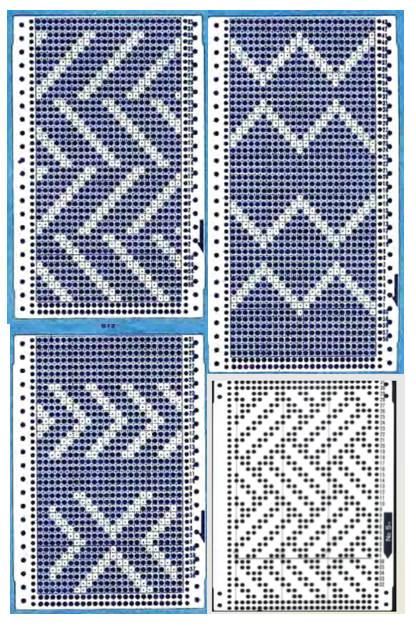 Remember that punchcards knit the image as viewed on the purl side of the fabric, so to match any swatch photos given in published pattern books, the exact repeat unless it is perfectly symmetrical, will usually need to be mirrored horizontally for use in electronic machines.
Remember that punchcards knit the image as viewed on the purl side of the fabric, so to match any swatch photos given in published pattern books, the exact repeat unless it is perfectly symmetrical, will usually need to be mirrored horizontally for use in electronic machines.
Similar shapes to the above, arranged differently: in A, arrows point to punched holes that create a vertical line containing 2 slipped rows followed by 2 knit ones, B is problematic because the long vertical white lines would mean the stitches corresponding to those locations on the needle bed would slip for the height of the punchcard, C is B color reversed to solve the problem, and suitable for slip-stitch knitting. An alternative for using B as is would be to have needles not selected in those all blank locations out of work on the main bed creating ladders (or transferred down to and in use on the ribber). As in any pattern knitting, if needles on the top bed are out of work, end needle selection must be canceled. If it is not, the needles adjacent to out-of-work needles will knit on every row, altering the planned pattern.
 The same shapes can be edited for use after rotating the original
The same shapes can be edited for use after rotating the original 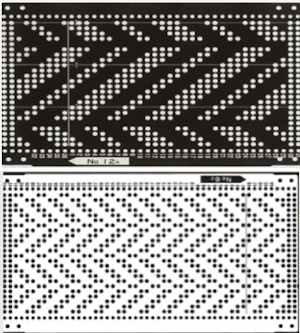 The 24-stitch repeat for the bottom option is shown, punchcard knitters would have to punch the height x4. The minimum electronic repeat is highlighted with a red border
The 24-stitch repeat for the bottom option is shown, punchcard knitters would have to punch the height x4. The minimum electronic repeat is highlighted with a red border 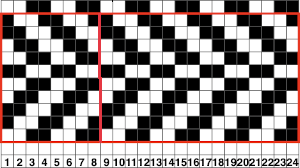 tiling to check the alignment of the 8X10 repeat.
tiling to check the alignment of the 8X10 repeat. 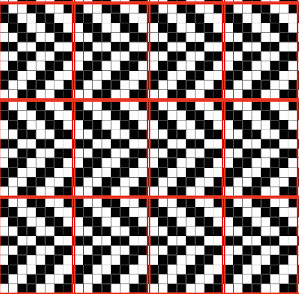 More repeats using similar lines, varying in density and consequently in their height: all knit rows (no white squares) make for easy to recognize color change possibilities and transitions
More repeats using similar lines, varying in density and consequently in their height: all knit rows (no white squares) make for easy to recognize color change possibilities and transitions 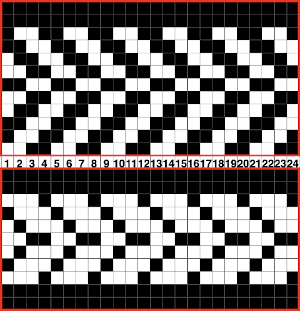 other possibilities using checks rather than solid lines
other possibilities using checks rather than solid lines 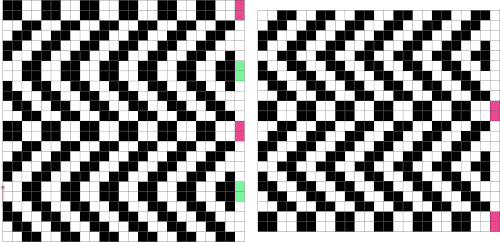 When evaluating published repeats, keep in mind the basics; these are suitable for electronic KMs that will allow for color reverse
When evaluating published repeats, keep in mind the basics; these are suitable for electronic KMs that will allow for color reverse 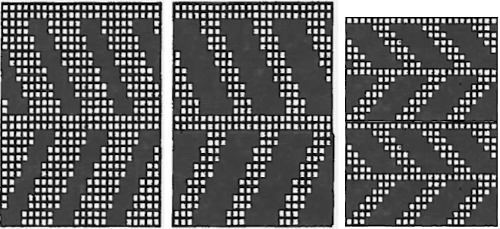 punchcard knitters would have to punch white squares, resulting in this arrangement
punchcard knitters would have to punch white squares, resulting in this arrangement 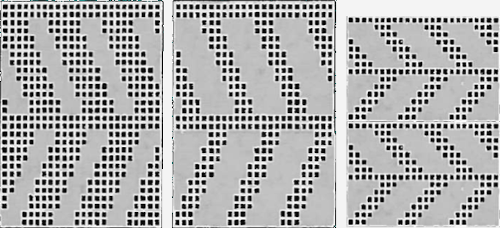 The knit side is not necessarily always interesting. With knit stripes in a different color breaking up the textured segments a secondary pattern will begin to emerge. A closer look at the samples below reveals one repeat is actually the other, drawn double length. This is an easy option, even in punch card machines. When knitting long pieces especially, however, I prefer not to use double-length built-in features, finding it easier to sort out where I am in terms of design rows if errors occur.
The knit side is not necessarily always interesting. With knit stripes in a different color breaking up the textured segments a secondary pattern will begin to emerge. A closer look at the samples below reveals one repeat is actually the other, drawn double length. This is an easy option, even in punch card machines. When knitting long pieces especially, however, I prefer not to use double-length built-in features, finding it easier to sort out where I am in terms of design rows if errors occur. ![]()
![]()
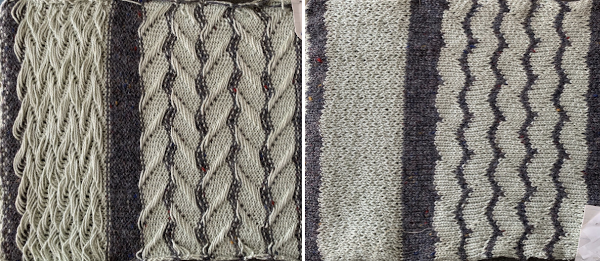
 Returning to a couple of the tuck stitch illustrations, adjusting the repeats for use with the slip stitch setting. Some of the color change sequences are suggested on the right side of the charts
Returning to a couple of the tuck stitch illustrations, adjusting the repeats for use with the slip stitch setting. Some of the color change sequences are suggested on the right side of the charts 
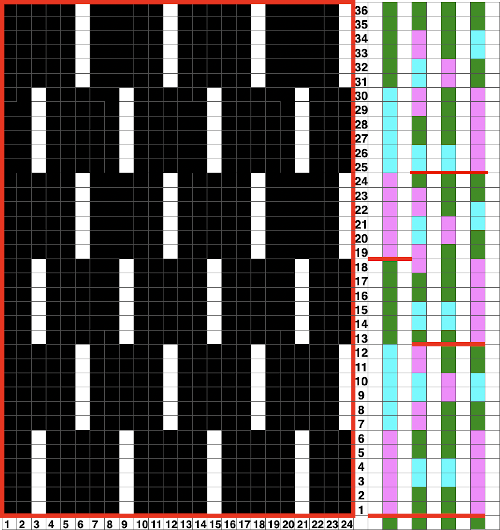
 The tuck stitch version,
The tuck stitch version,
 modifying it for use in slip stitch B, adding all knit rows between repeats A, and visualizing color placements on the knit side of the fabric.
modifying it for use in slip stitch B, adding all knit rows between repeats A, and visualizing color placements on the knit side of the fabric.  Depending on your machine ie Passap Duo requires 40 stitches punched repeats or modifying for electronics, vertical black columns or additional white squares may be added to the original design repeat units. The corresponding cells are filled with the color gray
Depending on your machine ie Passap Duo requires 40 stitches punched repeats or modifying for electronics, vertical black columns or additional white squares may be added to the original design repeat units. The corresponding cells are filled with the color gray 
 Testing the waters: a swatch using 4 colors, beginning with color changes every 6 rows, ending at the top with every 2, more variations are possible.
Testing the waters: a swatch using 4 colors, beginning with color changes every 6 rows, ending at the top with every 2, more variations are possible.  I have begun including .pngs with some of my posts. Check that your import method does not automatically change the mode to RGB. It is a common problem with such grabs from FB. If that happens, index the image to B/W and save it again before using it in download to KM software.
I have begun including .pngs with some of my posts. Check that your import method does not automatically change the mode to RGB. It is a common problem with such grabs from FB. If that happens, index the image to B/W and save it again before using it in download to KM software.
Making those shapes move: color striping variations for using 3 or 2 colors are seen on the right of the chart. The final surface may also work very well in a single color ![]()
 The resulting swatch is shown sideways for the sake of space. I usually begin tests with some striped knitting so I can be certain the color changer is threaded properly, that each color gets picked up without crossing or other issues, and that tension for any one color is not in conflict with that used with remaining colors. I am not a fan of the Brother single bed color changer, but it is a great convenience in fabrics such as these. A reminder when using it: add a lace extension rail on the left side. The carriage needs to clear the color changer far enough on its left for all colors to be picked up and changed properly
The resulting swatch is shown sideways for the sake of space. I usually begin tests with some striped knitting so I can be certain the color changer is threaded properly, that each color gets picked up without crossing or other issues, and that tension for any one color is not in conflict with that used with remaining colors. I am not a fan of the Brother single bed color changer, but it is a great convenience in fabrics such as these. A reminder when using it: add a lace extension rail on the left side. The carriage needs to clear the color changer far enough on its left for all colors to be picked up and changed properly  From long design studio inspiration swatches: the secondary shapes are created by varying the number of rows in the color change rotation and placement, the bottom swatch shows the purl side of part of the completed length. Float counts can help duplicate the repeat or color placements if notes are skipped during knitting.
From long design studio inspiration swatches: the secondary shapes are created by varying the number of rows in the color change rotation and placement, the bottom swatch shows the purl side of part of the completed length. Float counts can help duplicate the repeat or color placements if notes are skipped during knitting. 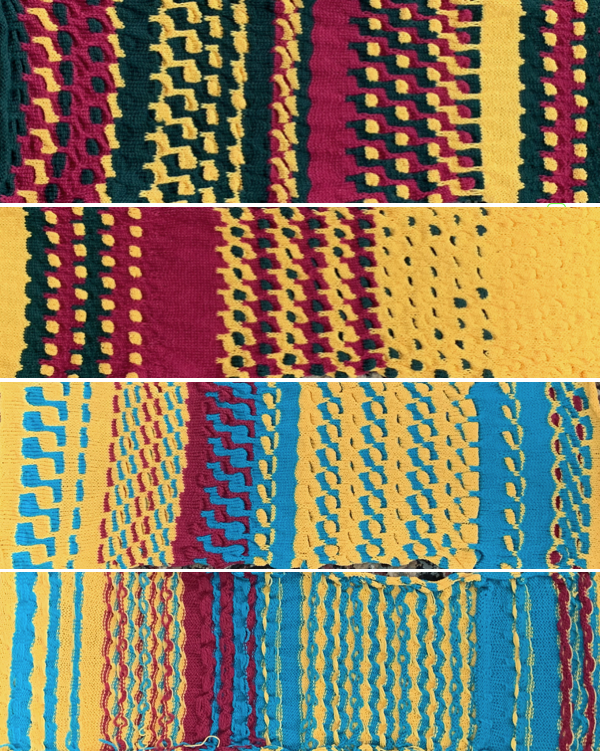 Working with multiple slip stitch “bars”: this shows my punchcard, marked with color changes once the final rotation was decided, remembering to begin markings 7 rows up from the bottom for Brother (5 for Studio).
Working with multiple slip stitch “bars”: this shows my punchcard, marked with color changes once the final rotation was decided, remembering to begin markings 7 rows up from the bottom for Brother (5 for Studio). 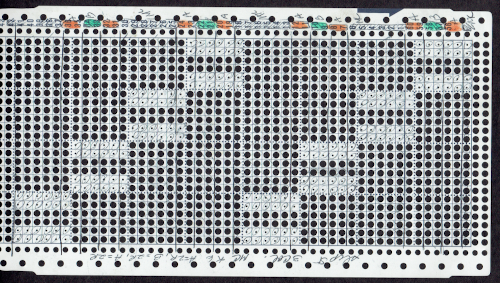 This design produces a fabric that is fairly flat on both sides: the .png is in the same orientation as the punchcard repeat, which you can see is produced with shapes reversed on the knit side in the swatches below it. Instructions on how the repeat was converted to .bmp for download using Gimp in post
This design produces a fabric that is fairly flat on both sides: the .png is in the same orientation as the punchcard repeat, which you can see is produced with shapes reversed on the knit side in the swatches below it. Instructions on how the repeat was converted to .bmp for download using Gimp in post ![]() The working chart, along with an effort to visualize the location of possible color changes in order to create secondary patterns. Color changing on “wrong rows” or starting preselection from the left rather than the right will result in random, not necessarily successful designs
The working chart, along with an effort to visualize the location of possible color changes in order to create secondary patterns. Color changing on “wrong rows” or starting preselection from the left rather than the right will result in random, not necessarily successful designs 

 This swatch segment illustrates the possibility of removing the slipped stitches from the needle bed and bringing them to the purl side, rehanging them on the same needles, bringing all needles out to hold before executing the next all knit row. The “floats” at the bottom of the swatch are from threads that were missed and not brought to the back of the slipped stitches
This swatch segment illustrates the possibility of removing the slipped stitches from the needle bed and bringing them to the purl side, rehanging them on the same needles, bringing all needles out to hold before executing the next all knit row. The “floats” at the bottom of the swatch are from threads that were missed and not brought to the back of the slipped stitches 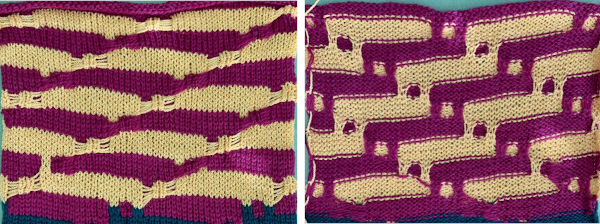
Attempting to visualize color changes using a larger, staggered repeat  which makes more sense when the image is tiled
which makes more sense when the image is tiled 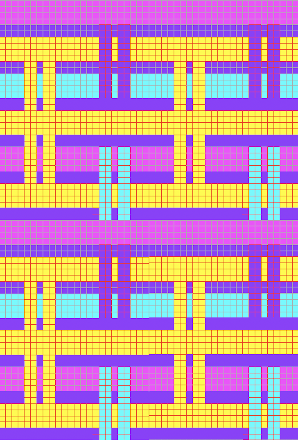

 Reducing the number of slipped rows
Reducing the number of slipped rows  reducing columns to produce a trim, being certain as to placement on the needle bed
reducing columns to produce a trim, being certain as to placement on the needle bed 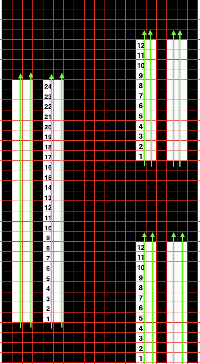 This repeat produces a ruched fabric when no all knit rows are included, and a sort of “honeycomb” effect when additional color changes on all knit rows are added. The first long swatch
This repeat produces a ruched fabric when no all knit rows are included, and a sort of “honeycomb” effect when additional color changes on all knit rows are added. The first long swatch ![]()
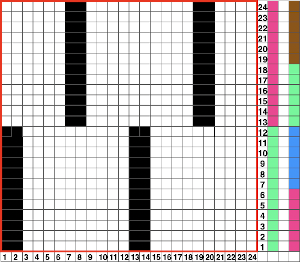

 The working repeat does not need to be symmetrical, using space-dyed yarn may result in a surface with an unrecognizable texture
The working repeat does not need to be symmetrical, using space-dyed yarn may result in a surface with an unrecognizable texture ![]()

 Shifting slip stitch units to form shapes
Shifting slip stitch units to form shapes![]()
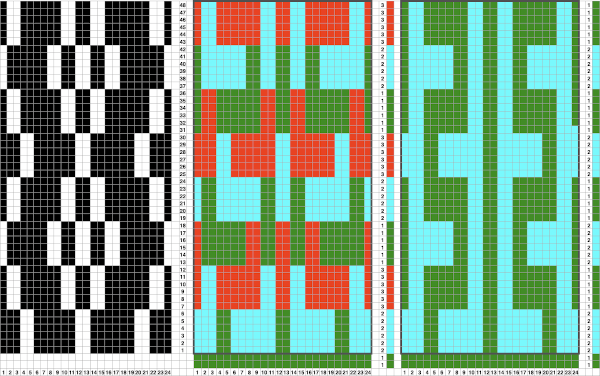

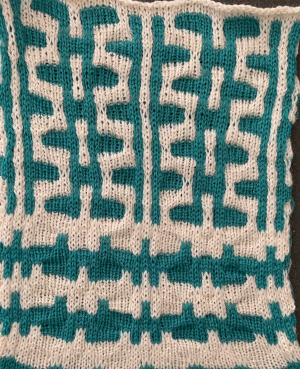 If the slip stitch units begin and end with the same color knitting just before them and immediately after, the color carried on the knit side will be consistent throughout.
If the slip stitch units begin and end with the same color knitting just before them and immediately after, the color carried on the knit side will be consistent throughout.  A sure way to get the shapes to match your design is to assign a number matching the number sequence in the color changer for your machine to each of the yarn colors. Imagining the results in a spreadsheet or even graph paper
A sure way to get the shapes to match your design is to assign a number matching the number sequence in the color changer for your machine to each of the yarn colors. Imagining the results in a spreadsheet or even graph paper 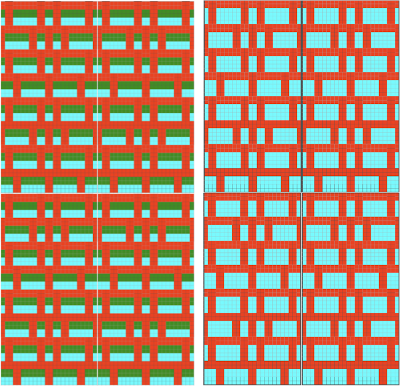 Expanding each section to 8 rows, the repeat now becomes 64 rows high and allows for 3 colors to show behind the slipped stitches in the chart on the left. On the right, the color-changing order shifts to 6 rows at a time in sequences 1,2,3,2,1,2,3. Design row 1 would begin the piece using the color red, the last row in the repeat is blue, shifting the color then carried up the front of the piece to blue.
Expanding each section to 8 rows, the repeat now becomes 64 rows high and allows for 3 colors to show behind the slipped stitches in the chart on the left. On the right, the color-changing order shifts to 6 rows at a time in sequences 1,2,3,2,1,2,3. Design row 1 would begin the piece using the color red, the last row in the repeat is blue, shifting the color then carried up the front of the piece to blue. 
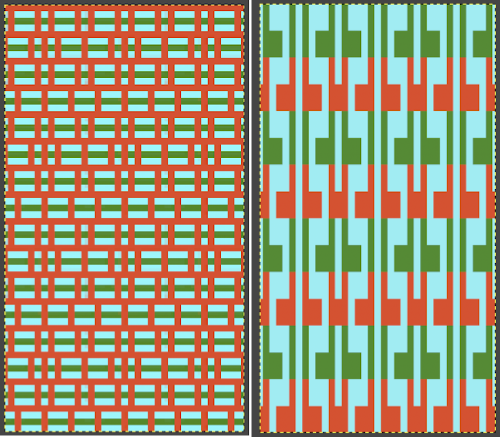 Once the basics are understood, changes in scale and amount of ruched textures along with fiber content are easier to execute
Once the basics are understood, changes in scale and amount of ruched textures along with fiber content are easier to execute  The chart for the sample below is 30 stitches wide by 84 rows high, and is shown turned counterclockwise
The chart for the sample below is 30 stitches wide by 84 rows high, and is shown turned counterclockwise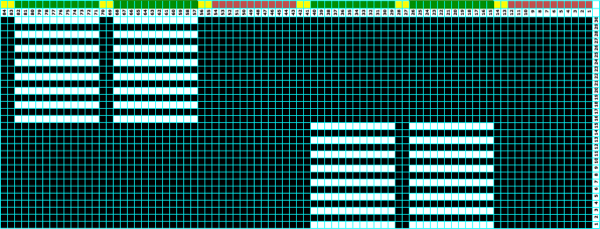
![]()
 This fabric has a more compressed shape, the blocks of slipped stitches are in a vertical arrangement directly above each other. A possible building unit for similar structures:
This fabric has a more compressed shape, the blocks of slipped stitches are in a vertical arrangement directly above each other. A possible building unit for similar structures: 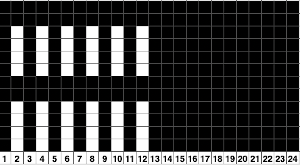
 An all-knit border on either edge automatically creates a ruffle on each side.
An all-knit border on either edge automatically creates a ruffle on each side.
Here the repeats on the left need to be color reversed before knitting, punchcard users will need to punch all white squares, leave the black ones unpunched, and repeat all once more in height. Some rows are omitted on the right, reversing the color placement for the “solid” shapes with the next knit row. 
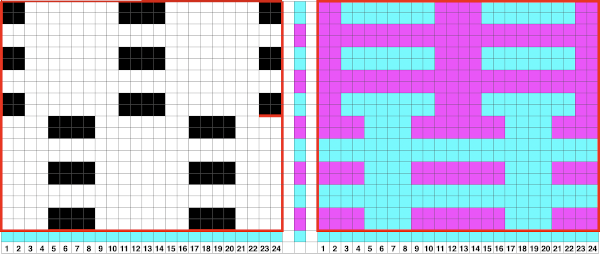

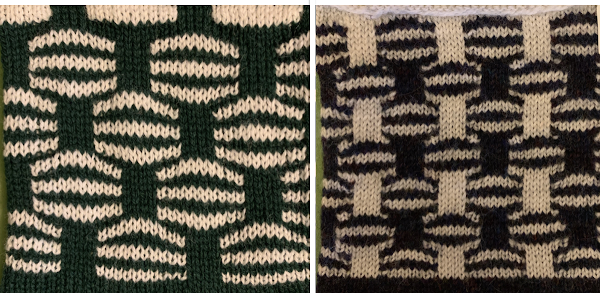 The 24X20 repeat for the swatch on the above right, with the floats easily identified on the purl side of the swatch
The 24X20 repeat for the swatch on the above right, with the floats easily identified on the purl side of the swatch ![]()
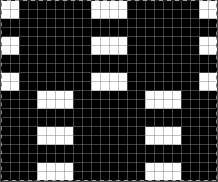
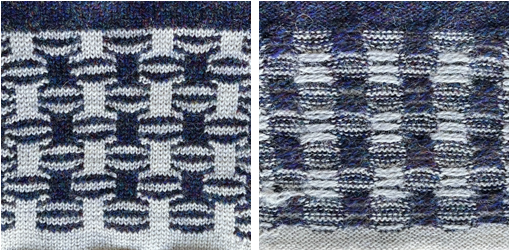 Blocks of slipped stitches (black squares in the chart, before color reverse) may be used to create 2 color fabrics that have no long floats in the ground color, electronics allow for more complicated shapes
Blocks of slipped stitches (black squares in the chart, before color reverse) may be used to create 2 color fabrics that have no long floats in the ground color, electronics allow for more complicated shapes If the goal is to produce specific shapes, then the way to achieve them is to use a color separation suitable for multiple color DBJ, knitting the fabric either on the single bed. The machine does not know whether the ribber is in use. Using DBJ software’s built-in options or even the Ayab middle color one twice merit their own future post.
If the goal is to produce specific shapes, then the way to achieve them is to use a color separation suitable for multiple color DBJ, knitting the fabric either on the single bed. The machine does not know whether the ribber is in use. Using DBJ software’s built-in options or even the Ayab middle color one twice merit their own future post.
Previous slip-stitch-related posts
2015/04/07/more-slip-stitch-experiments/
2013/09/02/a-random-slip-stitch/
2013/05/09/block-slip-stitch-separations/
For mosaic and mazes, execution, and design links to historical posts, see 2020/09/21/single-bed-tuck-…s-2-adding-color/
The slip stitch setting may also be used to automate a variety of fabrics, some of which involve organized color striping as well; the topic is discussed in other blog posts
Single bed tuck and slip stitch fabrics 2: adding color
Any tuck repeat may be used in the slip stitch setting. The results for “safe” repeats executed in slip stitch may not be very textural or dramatic.
Though at times presented in color, the same patterns can be very effective in single colors as well.
Prior to testing multicolor patterns, I like to start the work with waste yarn, testing color changes there first, making certain colors are threaded properly, not crossed, and that the color changer is set up properly.
The Brother single bed color changer is unique, in that the yarn remains in the changer, not leaving it with each color change; its manual
In the absence of a single bed changer, some fabrics may be knit with the ribber up, using the double bed model. This is the only option available for the bulky machine. There is a limit as to the amount of tucking that can be achieved successfully since the ribber arm does not have the system of wheels and brushes that help keep loops and stitches in place single bed. Manuals
Instructions from the Brother single bed color changer manual 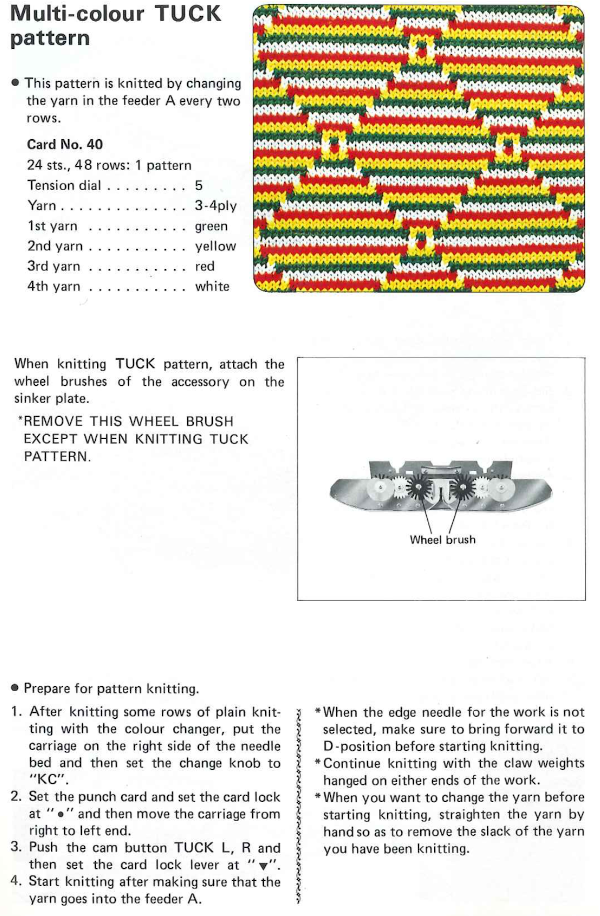
Punchcard volume collections are a great place to start to search for published repeats and subsequent DIY inspiration.
One such is Brother volume 5 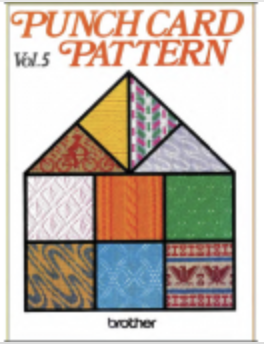 Since the knit carriage needs to move to and from the left-hand side of the machine with each color change, an even number of rows in each repeating segment is recommended, but not necessarily required. The first preselection row is generally moving from right to left. End needle selection on helps the edge stitches knit. At times end needles will need to be pushed forward to knitting position by hand. Depending on how the repeat is placed on the needle bed, with some experience with a tuck or slip stitch, one can decide whether keeping the end stitches in the pattern creates a better effect at vertical edges. Analyzing 2 random repeats
Since the knit carriage needs to move to and from the left-hand side of the machine with each color change, an even number of rows in each repeating segment is recommended, but not necessarily required. The first preselection row is generally moving from right to left. End needle selection on helps the edge stitches knit. At times end needles will need to be pushed forward to knitting position by hand. Depending on how the repeat is placed on the needle bed, with some experience with a tuck or slip stitch, one can decide whether keeping the end stitches in the pattern creates a better effect at vertical edges. Analyzing 2 random repeats 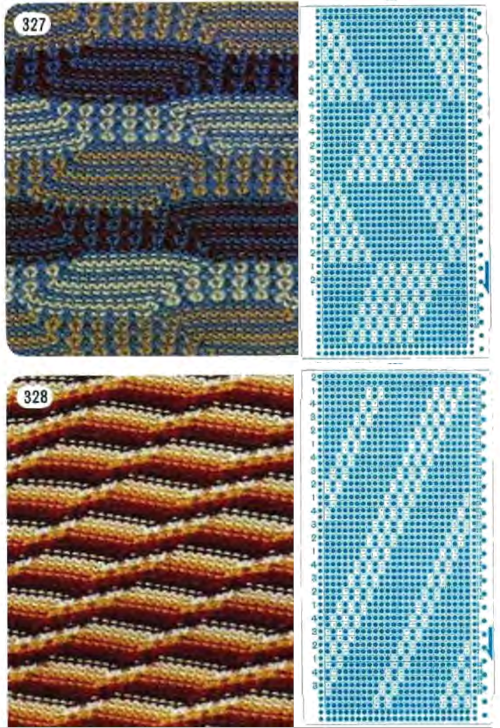 The respective .bmps
The respective .bmps![]()
![]() As with all punchcards, the first and last 2 pairs or rows are not part of the design, they are necessary for the punchcard to roll continuously in the drum. Keep in mind that the card is reading design row one while your eye sees the row marked #1 by the factory on the card outside of the machine. Following the suggested color changes to match the specific swatch takes the guesswork out of the equation. In DIY or in trying a different color sequence, such guides may have to be shifted and marked accordingly. Specific color suggestions are given in the samples above in the left-hand columns. In #327 the order is in a variable sequence, which requires a bit more attention than #328. Follow the line below the #1 mark to the left, each card begins with color 1. Color notations in 328 are also next to those 2 all punched rows at the top. That is because those 2 rows overlap the first 2 design rows as the ends of the card are clipped together, front over back, for smooth, continuous, advancing movement. In 327 the sequence at the bottom would need to be hand-marked.
As with all punchcards, the first and last 2 pairs or rows are not part of the design, they are necessary for the punchcard to roll continuously in the drum. Keep in mind that the card is reading design row one while your eye sees the row marked #1 by the factory on the card outside of the machine. Following the suggested color changes to match the specific swatch takes the guesswork out of the equation. In DIY or in trying a different color sequence, such guides may have to be shifted and marked accordingly. Specific color suggestions are given in the samples above in the left-hand columns. In #327 the order is in a variable sequence, which requires a bit more attention than #328. Follow the line below the #1 mark to the left, each card begins with color 1. Color notations in 328 are also next to those 2 all punched rows at the top. That is because those 2 rows overlap the first 2 design rows as the ends of the card are clipped together, front over back, for smooth, continuous, advancing movement. In 327 the sequence at the bottom would need to be hand-marked.
Before tackling patterns with moving components, these charts begin to analyze color changes in a ready punched or self-designed card which produces a honeycomb-like effect. The chart colors used are random picks from the palette, for illustration purposes only, illustrating areas where color changes may occur. The tuck/slip stitch held in the hook of non selected needles gets elongated and comes forward on the knit side, creating vertical lines in the color that is not knitting. The blue highlights the row where a single stitch, single row tuck or slipped stitch is created and the corresponding positions of the yarn on the knit side of the fabric 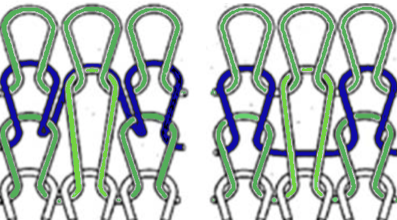 Four tucked rows is probably the limit on Brother machines unless one is working in fine yarns. In the first interpretation, the ground knits for 2 rows on all preselected needles. In the second, the surrounds of the interior striping knit for single rows only at the top and bottom of the repeat. Electronic repeats A and B on the right may be as small as a single 4X12 unit.
Four tucked rows is probably the limit on Brother machines unless one is working in fine yarns. In the first interpretation, the ground knits for 2 rows on all preselected needles. In the second, the surrounds of the interior striping knit for single rows only at the top and bottom of the repeat. Electronic repeats A and B on the right may be as small as a single 4X12 unit.
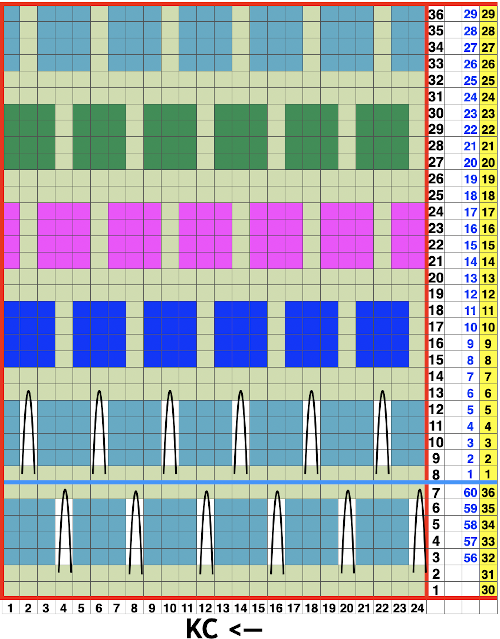 The same card may be used, altering the color-changing sequence so the ground that will surround the tuck or slipped stitches changes as well. Using the same card would require a pattern start on card marking row 2, and an initial preselection row from the left to the right
The same card may be used, altering the color-changing sequence so the ground that will surround the tuck or slipped stitches changes as well. Using the same card would require a pattern start on card marking row 2, and an initial preselection row from the left to the right 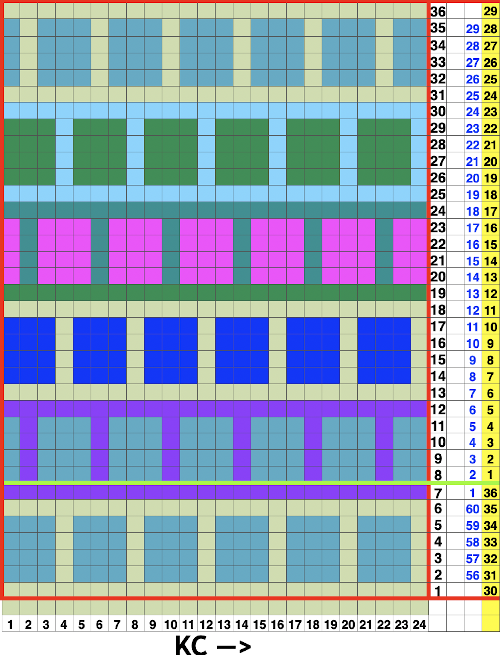 Keeping the 4 tuck row maximum the blocks of knit stitches between tucks can be varied, as can the movement of the vertical bars. The card repeat on the left would preselect from the right, while the repeat on the right would preselect from the left.
Keeping the 4 tuck row maximum the blocks of knit stitches between tucks can be varied, as can the movement of the vertical bars. The card repeat on the left would preselect from the right, while the repeat on the right would preselect from the left.  So the card on the right is already punched, and instead of changing the colors outlining the shapes, one wants them constant and with a start from the right? The workaround is to advance the card to the last row in the full repeat, #36, lock the card, and preselect toward the color changer continuing to change colors in 2 then 4-row rotations after releasing the card. Tiling the repeats multiple times as with any pattern helps isolate areas where color changes might work as well as give us a sense of pattern movement across the fabric. With so many tucked rows so close to each other, it is best to use thin yarn.
So the card on the right is already punched, and instead of changing the colors outlining the shapes, one wants them constant and with a start from the right? The workaround is to advance the card to the last row in the full repeat, #36, lock the card, and preselect toward the color changer continuing to change colors in 2 then 4-row rotations after releasing the card. Tiling the repeats multiple times as with any pattern helps isolate areas where color changes might work as well as give us a sense of pattern movement across the fabric. With so many tucked rows so close to each other, it is best to use thin yarn. 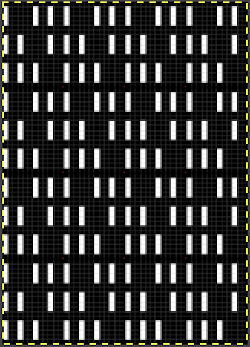
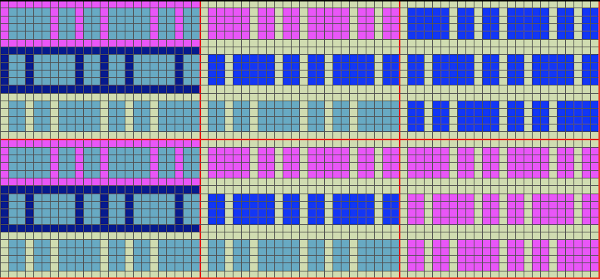 For slightly thicker yarn, one possible “fix” might be to simply eliminate one of the 3 tuck bars across the repeat, again check tiling for any errors, or places for color changes. Here the shift is not completed, some tuck bars were not eliminated
For slightly thicker yarn, one possible “fix” might be to simply eliminate one of the 3 tuck bars across the repeat, again check tiling for any errors, or places for color changes. Here the shift is not completed, some tuck bars were not eliminated 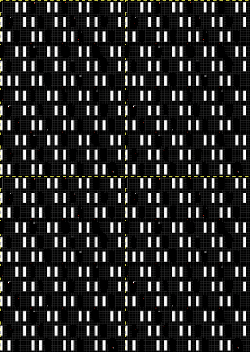 the “corrected” repeat without additional rows, some possible color changes can follow the colored chart suggestions
the “corrected” repeat without additional rows, some possible color changes can follow the colored chart suggestions ![]()
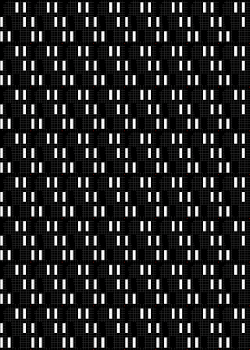 Moving on to electronics, playing with symmetry the repeat now becomes 30 stitches wide, the tiled image check for the unaltered version on the left.
Moving on to electronics, playing with symmetry the repeat now becomes 30 stitches wide, the tiled image check for the unaltered version on the left.  The repeated adjusted two different ways in height to accommodate color changes in a few different spots
The repeated adjusted two different ways in height to accommodate color changes in a few different spots  Working with repeats with tuck or slip bars that are only 2 rows high make for easier use of a range of yarn thicknesses. There are some surprises to be found when color changes are made as often as every 2 rows, sometimes using up to 4 colors. The extra all knit rows may be eliminated altogether.
Working with repeats with tuck or slip bars that are only 2 rows high make for easier use of a range of yarn thicknesses. There are some surprises to be found when color changes are made as often as every 2 rows, sometimes using up to 4 colors. The extra all knit rows may be eliminated altogether.
Beginning with a pattern that has large areas of black squares can help one understand what happens to the design as that knit ground takes on color striping in the same frequency as the color changes. The yarn used here is a 3/8 wool, making the fabric a bit stiff. The repeat is a larger cousin of card #327. Before the days of software tiling methods, on way to check repeats was to knit them up as Fair Isle. The large floats in this made it not its best use, the floats were sometimes caught with the companion color or looped. Had the long floats been consistently free, they could have been cut for a fringed look on the purl side and would have held in place well. 
 Tuck knit in a solid color
Tuck knit in a solid color 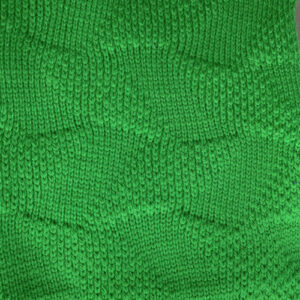
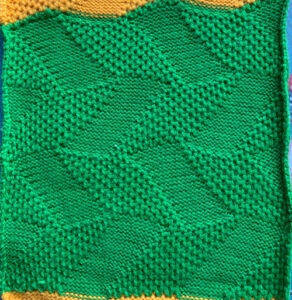 Slip stitch in all variations has purl side edges which curl to a greater degree, the short skipped areas were probably due to too tight tension of too quick a carriage pass to the opposite side
Slip stitch in all variations has purl side edges which curl to a greater degree, the short skipped areas were probably due to too tight tension of too quick a carriage pass to the opposite side 
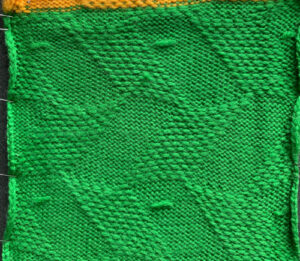 tuck alternating two colors every 2 rows
tuck alternating two colors every 2 rows 
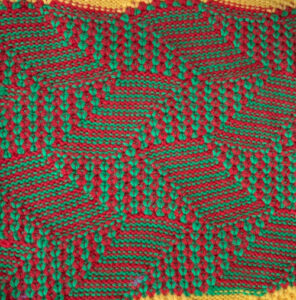 slip stitch 2 color variation
slip stitch 2 color variation 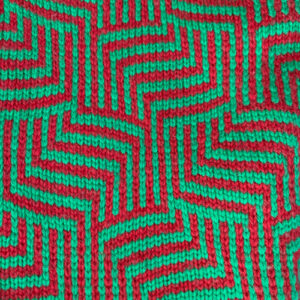
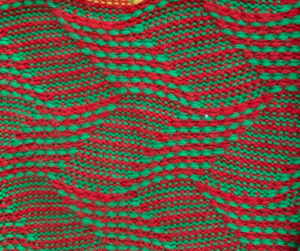 slip stitch with the addition of a third color in the rotation
slip stitch with the addition of a third color in the rotation 
 The associated punchcard:
The associated punchcard:  Some patterns using color rotations every two rows are referred to as mosaics, mazes, or floatless fair isle. They can be deliberately designed, but there are treasure troves of working repeats in punchcard pattern books that produce visual cousins and may also knit up as lovely fabric in single colors, and wonderful surprises at times when one designed for single color is striped. A few to try that are pictured with corresponding swatches shown on the knit side: from volume 5, the grey cells indicate the page numbers that correspond to the thumbnails in the downloadable version
Some patterns using color rotations every two rows are referred to as mosaics, mazes, or floatless fair isle. They can be deliberately designed, but there are treasure troves of working repeats in punchcard pattern books that produce visual cousins and may also knit up as lovely fabric in single colors, and wonderful surprises at times when one designed for single color is striped. A few to try that are pictured with corresponding swatches shown on the knit side: from volume 5, the grey cells indicate the page numbers that correspond to the thumbnails in the downloadable version  from Stitchworld, I have included repeat sizes, grey highlighted ones are suitable for use in punchcard as given
from Stitchworld, I have included repeat sizes, grey highlighted ones are suitable for use in punchcard as given 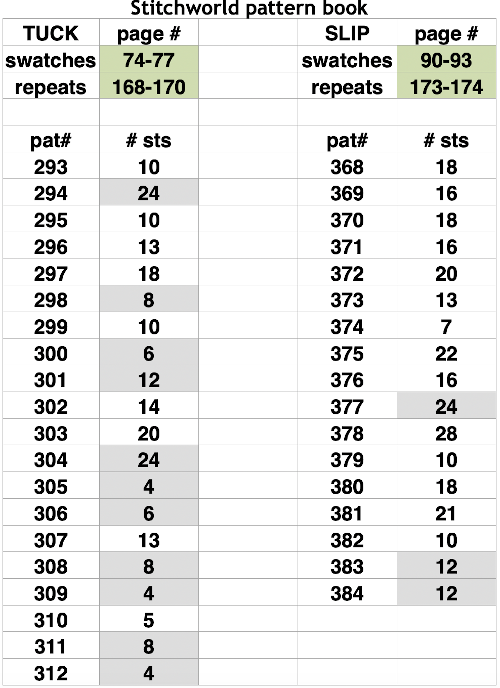 Brother yarn changers are numbered, from right to left, and their published card designs color suggestions reflect that. The lace extension rail must be used as the knit carriage needs to clear the color changer on that side in order for the colors to change properly.
Brother yarn changers are numbered, from right to left, and their published card designs color suggestions reflect that. The lace extension rail must be used as the knit carriage needs to clear the color changer on that side in order for the colors to change properly. 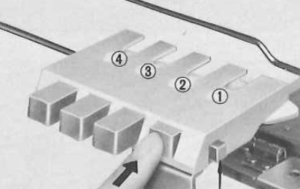 The Studio color changer color positions are marked with letters of the alphabet from left to right
The Studio color changer color positions are marked with letters of the alphabet from left to right 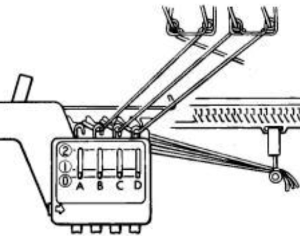 Some of the Studio punchcard pattern books showed both sides of the expected fabric assi\ociated with each card, here is a repeat that breaks the tuck rule of no more than one blank square side by side in any row.
Some of the Studio punchcard pattern books showed both sides of the expected fabric assi\ociated with each card, here is a repeat that breaks the tuck rule of no more than one blank square side by side in any row.
 This swatch pattern from a Japanese magazine illustrates the difference in the formation of the tucked loops when two blank squares exist side by side. The repeat is 10X22, and the colors are assigned letters rather than numbers here as well.
This swatch pattern from a Japanese magazine illustrates the difference in the formation of the tucked loops when two blank squares exist side by side. The repeat is 10X22, and the colors are assigned letters rather than numbers here as well. Another rule breaker: odd numbers of tucked rows with no added all-knit rows. Experimenting with such repeats results in less organized all-over patterns, here colors are changed every 2 rows,
Another rule breaker: odd numbers of tucked rows with no added all-knit rows. Experimenting with such repeats results in less organized all-over patterns, here colors are changed every 2 rows,  every 4 rows
every 4 rows  A single knit row may be added, for an added variation with color changes every 4 rows
A single knit row may be added, for an added variation with color changes every 4 rows  These repeats take shapes in another direction which becomes more textural and interesting when blank stitch areas are expanded for use in slip stitch setting
These repeats take shapes in another direction which becomes more textural and interesting when blank stitch areas are expanded for use in slip stitch setting 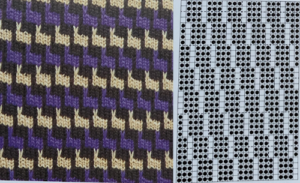
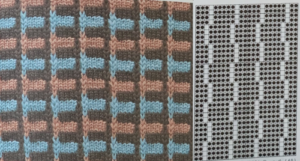 This pattern, with color changes every 2 rows and two-row tuck sequences has an assumed interesting pattern shift.
This pattern, with color changes every 2 rows and two-row tuck sequences has an assumed interesting pattern shift. 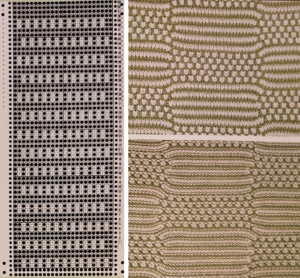 The tiled X2 horizontal repeats lined up side by side show that extra knit stitches have been added, shifting tuck stitch rows by one stitch in alternating directions, but just because it is published, it does not necessarily make the repeat correct. Those striped areas can only occur if there are solid all punched areas.
The tiled X2 horizontal repeats lined up side by side show that extra knit stitches have been added, shifting tuck stitch rows by one stitch in alternating directions, but just because it is published, it does not necessarily make the repeat correct. Those striped areas can only occur if there are solid all punched areas.  Keeping the constraints of a 24 stitch repeat, reducing the width of segments to 12 stitches rather than 24, the original repeat as amended
Keeping the constraints of a 24 stitch repeat, reducing the width of segments to 12 stitches rather than 24, the original repeat as amended 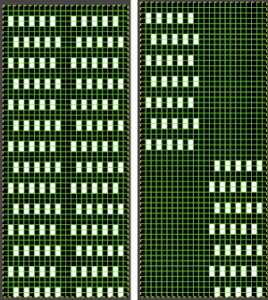 The tiled results for each
The tiled results for each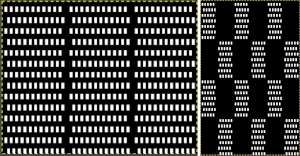 24X56 repeat proof of concept swatch in a far thinner yarn than the book photo
24X56 repeat proof of concept swatch in a far thinner yarn than the book photo ![]()
 An approach to designing such patterns can begin with a template for color changing every 2 rows and taking colored squares away to indicate stitches that will be slipped or tucked.
An approach to designing such patterns can begin with a template for color changing every 2 rows and taking colored squares away to indicate stitches that will be slipped or tucked.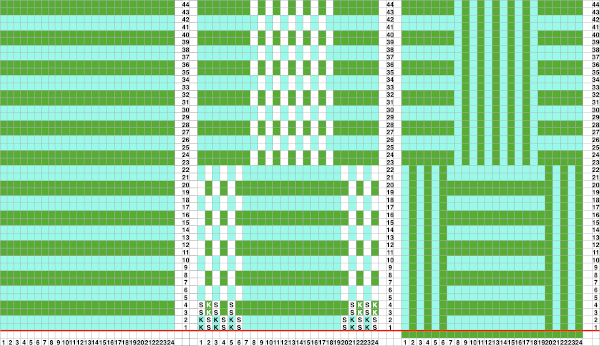 Repeats can be adjusted from wider electronic ones to the 24 stitch width constraint for punchcard machines, as well as shifted to change the resulting shapes and their colors on the knit side. The two-dimensional charts are not capable of reflecting the amount of gathering of the fabrics or distortions of the stripes on the completed knit
Repeats can be adjusted from wider electronic ones to the 24 stitch width constraint for punchcard machines, as well as shifted to change the resulting shapes and their colors on the knit side. The two-dimensional charts are not capable of reflecting the amount of gathering of the fabrics or distortions of the stripes on the completed knit 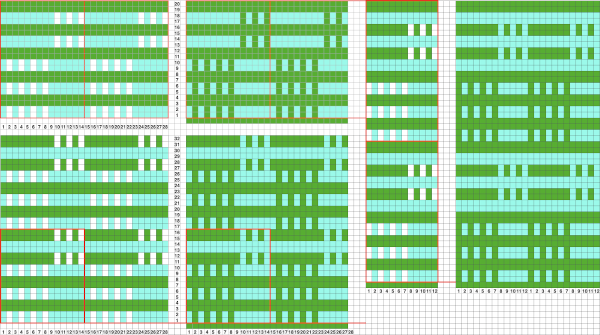 Japanese magazine publications often recommended many color changes, each for varied numbers of rows. Sometimes more is less. The number of colors may be reduced, and changing the numbers of rows used for each color as well can expand the number of fabrics produced from a single repeat. Good note keeping is a necessity if the intent is to easily reproduce the fabric at a later time.
Japanese magazine publications often recommended many color changes, each for varied numbers of rows. Sometimes more is less. The number of colors may be reduced, and changing the numbers of rows used for each color as well can expand the number of fabrics produced from a single repeat. Good note keeping is a necessity if the intent is to easily reproduce the fabric at a later time.
Mixing things up for vertical designs: 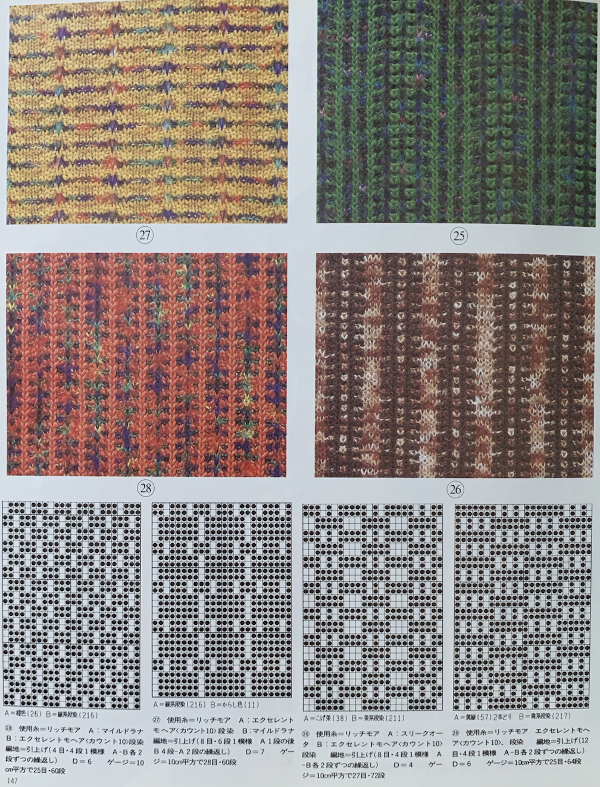 Adapting punchcard designs for use in electronics becomes easier once one is familiar with the stitch structure. This is a cousin of 328, 13 stitches X 52 rows. Tiling as in all designs helps sort out errors or missing pixels.
Adapting punchcard designs for use in electronics becomes easier once one is familiar with the stitch structure. This is a cousin of 328, 13 stitches X 52 rows. Tiling as in all designs helps sort out errors or missing pixels.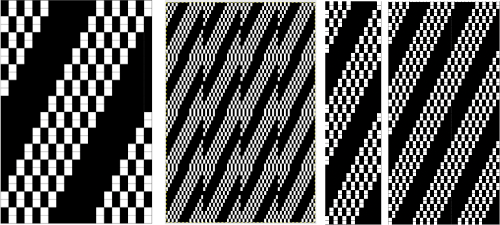 The “corrected” pattern, with the accompanying test swatches, the first knit in tuck stitch changing colors every 4 rows
The “corrected” pattern, with the accompanying test swatches, the first knit in tuck stitch changing colors every 4 rows ![]()
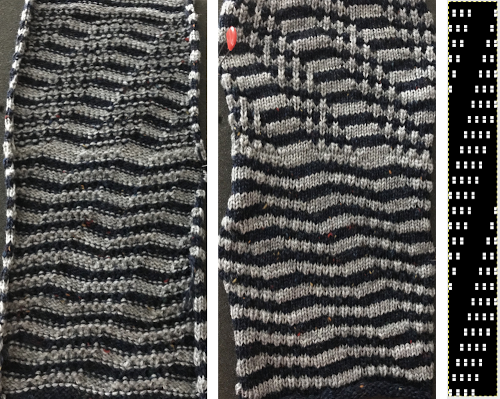 and slip stitch changing colors alternately every 2 rows, then every 4:
and slip stitch changing colors alternately every 2 rows, then every 4: 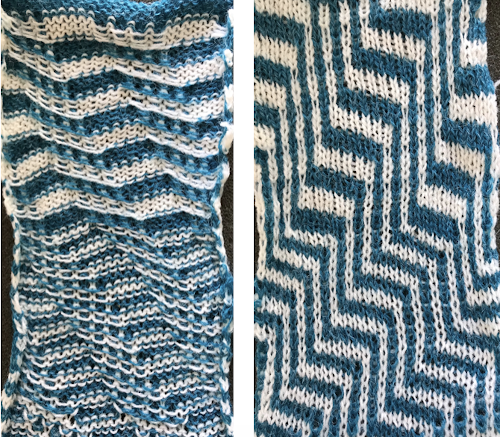 My blog posts on working with and designing mosaics (suitable for tuck and slip) and mazes (slip stitch only, multiple side by side unpunched holes or white squares in any row), in reverse historical order
My blog posts on working with and designing mosaics (suitable for tuck and slip) and mazes (slip stitch only, multiple side by side unpunched holes or white squares in any row), in reverse historical order
2019/06/29/mosaics-and-maze…numbers-and-gimp/
2015/10/21/working-with-gen…-gimp-charting-2/
2015/10/03/working-with-gen…mazes-charting-1/
2012/10/15/mosaics-and-maze…design-to-pattern/
2013/05/06/mosaics-and-mazes-drawing-motifs/
2012/10/15/mosaics-and-maze…design-to-pattern/
2012/09/22/mosaic-and-maze-…-on-the-machines/
Single bed tuck and slip stitch fabrics 1
The main difference between the 2 stitch types is that in tuck stitch the strand of yarn on the non-selected needle is held in the hook of the needle forming a loop,  while in slip stitch the strand of yarn bypasses the non-selected needles as the row is knit, forming floats between stitches
while in slip stitch the strand of yarn bypasses the non-selected needles as the row is knit, forming floats between stitches 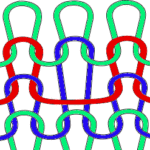 Symbols commonly used for both
Symbols commonly used for both![]() In both instances the stitch on non-selected needles when the pattern begins (blue row in photo) is held in that needle hook, growing in length until that same needle is selected, and with the next row of knitting (red) one returns to the standard knit stitch formation.
In both instances the stitch on non-selected needles when the pattern begins (blue row in photo) is held in that needle hook, growing in length until that same needle is selected, and with the next row of knitting (red) one returns to the standard knit stitch formation.
Both distort the fabric, the tuck stitch widens and shortens it, while the slip stitch narrows and also shortens it. Both are capable of producing textured, interesting fabrics on only one or on both sides of the knit depending on the pattern’s design repeats. Which side is chosen as the public side is simply a matter of preference. In accessories and clothing, the interplay and “reversible” effects can provide added interest.
Because in tuck knitting the stitches are being held and gathered, more rows will be required to produce the desired length in pieces. Because the knit gets stretched sideways fewer stitches will be required to achieve the wanted width, making it suitable where larger garment pieces are planned. Looking at the stitch in a 2D diagram: A– loops are created for 2 rows, the original stitch is shown elongated. Each patterning needle hook now holds 3 yarn ends. B– the needle coming forward prior to the next pass whether by card reader selection or by hand, will knit on the next carriage pass to the opposite side. C– the originally held stitch as it might appear on the knit side
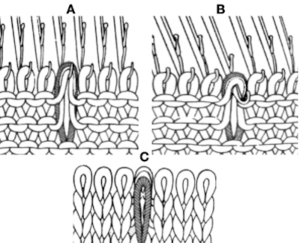 The group of loops as they knit together then forms small lumps/ bumps, or what I think of as “butterflies”.
The group of loops as they knit together then forms small lumps/ bumps, or what I think of as “butterflies”.
The capacity of the needle hooks in terms of the number of loops they can hold and the quality and thickness of the yarn used place quick limitations of the number of rows one may use for tuck patterning. The Passap system tolerates many more such rows than the Japanese model machines, where the limit is often 4 rows. Slip-stitch is far more flexible in terms of applied “rules”.
Brother controls for patterning in any model are by the selection of cam buttons that offer directional arrows on the carriage  Some of the options:
Some of the options: 
 and not often used, but worth exploring, the use of opposing tuck and slip buttons at the same time.
and not often used, but worth exploring, the use of opposing tuck and slip buttons at the same time. 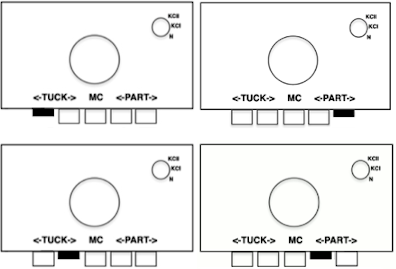 As with any knitting, for needle selection to occur the knit carriage (also known as KC) needs to engage the belt using the change knob set to KC. End needle selection or not depends on the goal fabric. If KC is in use but no cam buttons are pushed in, there will be needle selection, but the fabric produced will remain stocking stitch.
As with any knitting, for needle selection to occur the knit carriage (also known as KC) needs to engage the belt using the change knob set to KC. End needle selection or not depends on the goal fabric. If KC is in use but no cam buttons are pushed in, there will be needle selection, but the fabric produced will remain stocking stitch.
Any tuck cards may be used in the slip setting, but the reverse is not true.
Functions are in the directions of the arrows. For example, if a left button is pushed in, the next carriage pass will form loops or skipped stitches while traveling from right to left on the non preselected needles, and knit stitches on all needles on the return pass to the right, aside from any preselection being present. If both buttons are pushed in, the knit will form loops or skipped stitches with each carriage pass on non selected needles until those needle positions are pre-selected again, and then the stitches held in the hooks of the needles will knit with the next carriage pass.
It is possible to create the stitch structure on any machine, including manually by pulling selective needles out to hold for X number of rows. Motifs may be short or long, all over or isolated, can be arranged vertically, horizontally, diagonally, in diamond, basketweave, and plaid effects, may be combined with the use of stitches on the opposite bed, and with needles out of work (OOW) on either or both beds.
Punchcards are restricted to a maximum of 24 stitches or factors of 24 in the width of the repeats and require a minimum of 36 rows if they are to be used in continuous patterning. In electronics, the basic rules should be followed, but a single small repeat is enough to program, the size of large non-repetitive ones is limited only by machine memory and mode of download.
Both fabrics like to be weighted evenly, and several rows of waste yarn should be used at the start of the piece prior to testing patterns. Because it will be wide or narrow and short, that is a consideration if the plan is to combine several types of stitches in the same garment. Gauge swatches should be larger than usual.
Boiling things down to black and white: in both tuck and slip automatic patterning, selected needles produce knit stitches. Punchcard knitters are required to punch a hole for every knit stitch, leaving only areas that will be forming the tuck loops or skip stitch floats blank on the card. In a published chart for the stitch is used, black squares may be used to represent knit stitches and rows, white ones the tuck or slip stitch locations. It is up to the user to determine whether if using a published source, color reversing the repeat in electronics, or punching out the all-white areas as opposed to black is required. In single bed stitch formation, if one knits with two or more empty needles in work side by side, it will quickly become evident stitches will not form properly on those needles without additional steps being taken. This remains true in tuck knitting, but not in slip stitches. Though there are some exceptions, the usual rule is to have no more than one unit in any row without a punched hole or black square/pixel on either side of it. Punchcard pattern books are a great source of “safe” repeats. Electronic users need to isolate and draw a minimum of one repeat, which may be quite small. If duplicating a whole card with fewer unpunched holes than punched ones, only the white squares need to be drawn as black, and later the repeat is color reversed. Punchcard patterns usually have two rows of all punched holes at the top and bottom of the card that will rest on the first and last 2 rows of the design repeat respectively, allowing for the card to roll continuously in its reader. Cards also need a recommended minimum of 36 rows. Brother #1 mark on the right is 7 rows up from the bottom, while the card reader is reading design row one inside the machine, out of view. Cards from other KM manufacturers may be used, but the starting row may differ, as was also true back in mylar days. Punchcard machines produce the pattern as drawn on the purl side. Some electronic models or download programs vary, and may require the pattern to be flipped horizontally.
An easy way to start becoming familiar with the knit structure of stitches is to begin by working with “safe” design repeats, using a familiar yarn in a light color. Depending on the punchcard machine model year, the card on the left (1) was a standard Brother issue, the one on the right (2) not always. Both may be used to test all cam buttons and stitch types, card one tolerates elongation well, card 2 may meet some resistance with tuck stitch if the yarn is thicker than the needle hooks will contain easily. 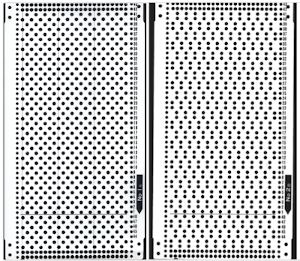 Converting the cards to black and white pixels: the small single repeats for each card are highlighted with a red border. Depending on the method for programming the electronic machine, however, the single repeat may have to be repeated horizontally to match the number of stitches to be used in the piece. The third repeat is a hybrid of the previous 2, the start of making what is published more personal
Converting the cards to black and white pixels: the small single repeats for each card are highlighted with a red border. Depending on the method for programming the electronic machine, however, the single repeat may have to be repeated horizontally to match the number of stitches to be used in the piece. The third repeat is a hybrid of the previous 2, the start of making what is published more personal 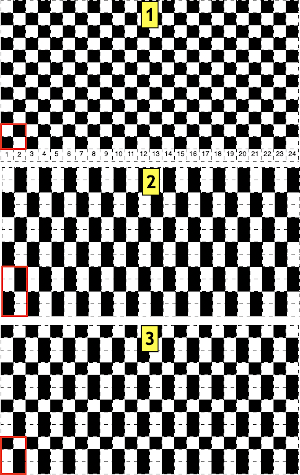 Studying published sources makes it easier to design more personal repeats. Cards that are “safe to use” can get one started in examining the texture and developing an understanding of how stitches are formed. They are often composed of variations of either card 1 or card 2 with added black areas. Using punchcards supplied in the packs with respective machine models appropriately can easily be done
Studying published sources makes it easier to design more personal repeats. Cards that are “safe to use” can get one started in examining the texture and developing an understanding of how stitches are formed. They are often composed of variations of either card 1 or card 2 with added black areas. Using punchcards supplied in the packs with respective machine models appropriately can easily be done  Additional published cards are also easily found increasing the number of tucked rows and observing the rule of knit stitches on both sides of the single unpunched squares resulting in no preselection. Below, some of the single repeats are outlined in red. With additional rows now tucking, the added insurance of having them knit off properly at regular intervals is achieved by all punched (or black squares) single rows, highlighted with orange squares on their left. The black border isolates the actual patterning rows in the designs. Again, the top and bottom pairs of all punched rows are not part of the overall design but are necessary for the punchcard machines to line up patterning for knitting a continuous design
Additional published cards are also easily found increasing the number of tucked rows and observing the rule of knit stitches on both sides of the single unpunched squares resulting in no preselection. Below, some of the single repeats are outlined in red. With additional rows now tucking, the added insurance of having them knit off properly at regular intervals is achieved by all punched (or black squares) single rows, highlighted with orange squares on their left. The black border isolates the actual patterning rows in the designs. Again, the top and bottom pairs of all punched rows are not part of the overall design but are necessary for the punchcard machines to line up patterning for knitting a continuous design  The blank vertical areas may be arranged moving across the repeat’s canvas in a variety of ways. In this chart the tuck symbol is evident, some of the knit stitches around each tuck series are highlighted at the bottom of the chart in green, the single electronic possible repeat is 4 sts by 12 rows
The blank vertical areas may be arranged moving across the repeat’s canvas in a variety of ways. In this chart the tuck symbol is evident, some of the knit stitches around each tuck series are highlighted at the bottom of the chart in green, the single electronic possible repeat is 4 sts by 12 rows 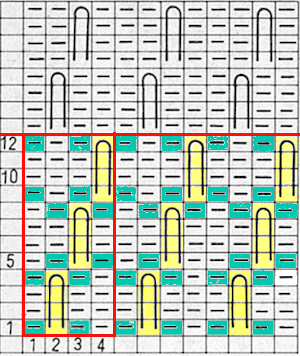 What may be confusing when symbols and charts such as the above are encountered is that the very first row of the symbol actually rests on the spot where the knit stitch that is being held for the next 3 rows rests, so design row 1, 5, 9, 13, etc are actually all knitted. The punchcard minus the all punched rows at its top and bottom:
What may be confusing when symbols and charts such as the above are encountered is that the very first row of the symbol actually rests on the spot where the knit stitch that is being held for the next 3 rows rests, so design row 1, 5, 9, 13, etc are actually all knitted. The punchcard minus the all punched rows at its top and bottom: 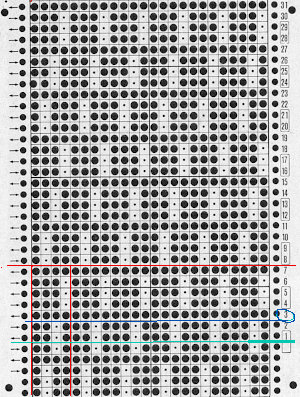 The factory-supplied blank cards may have arrows on the left, familiar in lace card designs. In the above case, the implied use is that the card start in the locked position on row 1 with the carriage on the right, preselecting to the left. If only a single color is to be used starting side does not matter. If regular color changes are recommended, more often than arrows dots, or color numbers are used in that column to indicate color change locations. In Brother machines, the first preselection row may be made from either left to right or right to left, depending on the fabric being created. With the exception of dbj using the KRC button or patterns that expressly specify the starting side, most patterns using the color changer will need a start from the right. Here if that is done, color changes could occur every 4, 8, or 12 rows using 2 or even 3 color sequences.
The factory-supplied blank cards may have arrows on the left, familiar in lace card designs. In the above case, the implied use is that the card start in the locked position on row 1 with the carriage on the right, preselecting to the left. If only a single color is to be used starting side does not matter. If regular color changes are recommended, more often than arrows dots, or color numbers are used in that column to indicate color change locations. In Brother machines, the first preselection row may be made from either left to right or right to left, depending on the fabric being created. With the exception of dbj using the KRC button or patterns that expressly specify the starting side, most patterns using the color changer will need a start from the right. Here if that is done, color changes could occur every 4, 8, or 12 rows using 2 or even 3 color sequences.
There is another issue to note. Counting up design rows from the bottom the card is marked row 1 five rows up. This is a Studio punchcard. If using it on a Brother machine, the starting row would actually occur with the card locked on row 3, color change row markings if given, would have to be altered accordingly.
The distribution of tuck stitches can occur in groups, or more sparsely. The card on the right begins to break the rules with 2 needles tucking side by side for 3 rows. Those areas create floats akin to those created by slip stitches as the side-by-side loops drop off the needles in those areas rather than knitting off together. As areas of white become less balanced, punchcard knitters may find it easier to mark the tuck bars and punch all else, electronic knitters draw the white as black, and color reverse.
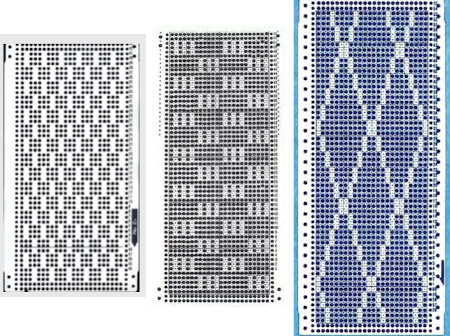 Few tuck stitches amidst lots of plain knitting are likely to not distort the fabric very much or produce a noticeable texture. The fabric will lie fairly flat, and approach a width proportionately closer to that of stocking stitch using the same yarn. The outlines can serve as markers for the introduction of additional hand techniques ie tying objects or beads in the center of the shapes after knitting and prior to felting in order to obtain surface bubbles of non felted stitches, or marking areas for duplicate-stitch or other embellishments.
Few tuck stitches amidst lots of plain knitting are likely to not distort the fabric very much or produce a noticeable texture. The fabric will lie fairly flat, and approach a width proportionately closer to that of stocking stitch using the same yarn. The outlines can serve as markers for the introduction of additional hand techniques ie tying objects or beads in the center of the shapes after knitting and prior to felting in order to obtain surface bubbles of non felted stitches, or marking areas for duplicate-stitch or other embellishments.
In some instances, thread lace repeats can provide DIY inspiration. With the color reversed, the structure for possible tuck can be observed and determined if suitable. In the bottom right image, those white solid lines are the easiest edit, shown in progress 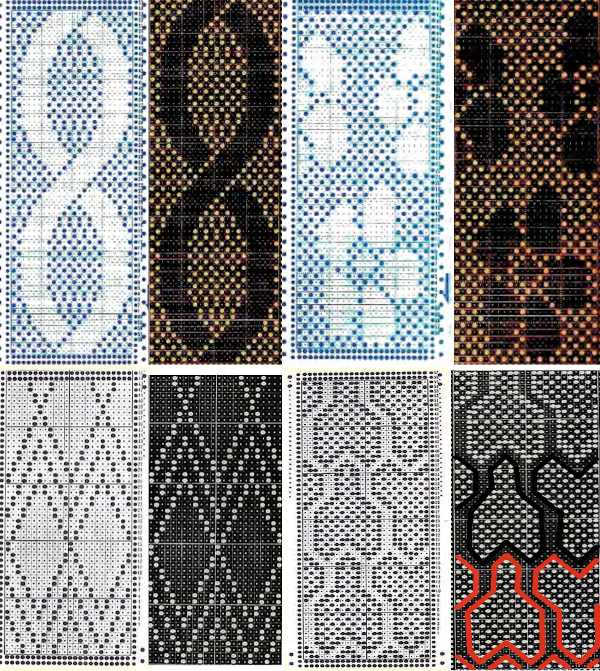 With the basic structure recognized, weaving punchcards may be suitable, not all need be color reversed.
With the basic structure recognized, weaving punchcards may be suitable, not all need be color reversed. 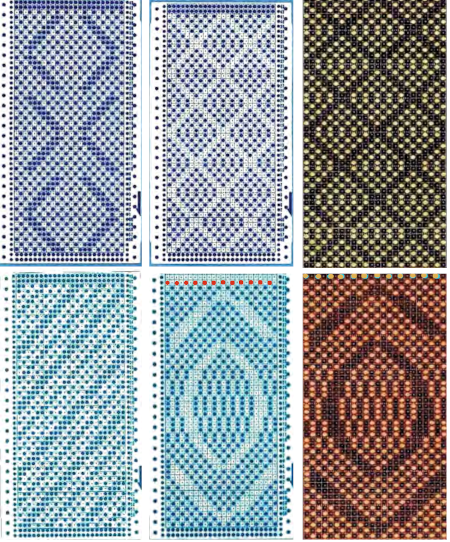 Electronic repeats may also be used directly or adapted for use on punchcard machines, providing the repeat unit is a factor of or up to a maximum of 24 stitches in width, which translates to 2,4,6,8,12, and 24, and repeated to the recommended minimum of 36 rows in height. For tuck stitch, those narrow vertical bars surrounded by black squares are the common factor. The StitchWorld pattern book charts require only matching a usable width for use in punchcard models since the knit stitches are shown as black squares. Here is a random selection
Electronic repeats may also be used directly or adapted for use on punchcard machines, providing the repeat unit is a factor of or up to a maximum of 24 stitches in width, which translates to 2,4,6,8,12, and 24, and repeated to the recommended minimum of 36 rows in height. For tuck stitch, those narrow vertical bars surrounded by black squares are the common factor. The StitchWorld pattern book charts require only matching a usable width for use in punchcard models since the knit stitches are shown as black squares. Here is a random selection  253 translates easily to this, it would need to be punched twice
253 translates easily to this, it would need to be punched twice  251 is a bit more problematic. Half the repeat is wider than 24 stitches. Here it is readjusted to 24 stitches, the height is 32 rows which may just barely squeak by punched only once
251 is a bit more problematic. Half the repeat is wider than 24 stitches. Here it is readjusted to 24 stitches, the height is 32 rows which may just barely squeak by punched only once  the repeat is tiled to check proper alignments
the repeat is tiled to check proper alignments 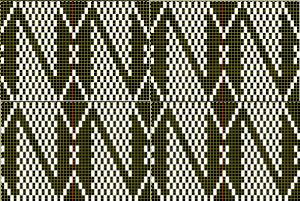 This repeat is from a Studio mylar sheet. It also may be used in punchcard machines after removing 2 columns, since only half the repeat is necessary, and it is 26 stitches in width. The color reverse option is necessary. In electronic machines, it is easily accomplished with a command or the flip of a switch/ push of a button. The white squares as given would produce loops on all the corresponding needles, with no stitch formation in those areas.
This repeat is from a Studio mylar sheet. It also may be used in punchcard machines after removing 2 columns, since only half the repeat is necessary, and it is 26 stitches in width. The color reverse option is necessary. In electronic machines, it is easily accomplished with a command or the flip of a switch/ push of a button. The white squares as given would produce loops on all the corresponding needles, with no stitch formation in those areas. 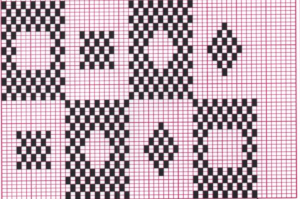 I chose to eliminate 2 columns from the blocks on the left. Tiling shows the amended repeat’s appearance, with the color reversed image for actual knitting to its the right.
I chose to eliminate 2 columns from the blocks on the left. Tiling shows the amended repeat’s appearance, with the color reversed image for actual knitting to its the right.  Repeats with a balanced number of black and white squares provide all-over textures in fairly balanced fabrics. As the number of black squares on a field of speckled tuck stitches grows, the knit shapes may actually poke out from the surface of the knit, since those areas are not gathered in the same way as their surroundings. Yarn properties and tension also have an effect.
Repeats with a balanced number of black and white squares provide all-over textures in fairly balanced fabrics. As the number of black squares on a field of speckled tuck stitches grows, the knit shapes may actually poke out from the surface of the knit, since those areas are not gathered in the same way as their surroundings. Yarn properties and tension also have an effect.
Design with very few black vertical single stitch “bars” are commonly found in patterns published for electronics, often also too large for use on punchcard models. As with lace, where there are few black pixels on large fields of white, caution in trimming the image is necessary. Tiling once again helps one locate possible errors. An example of such an image tagged as being 42X62: 
![]() tiled 42X62
tiled 42X62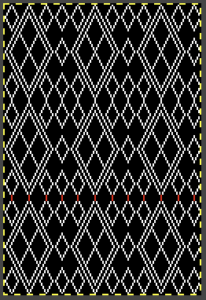 adjusting to avoid those 4 rows tucking consecutively, now 42X60
adjusting to avoid those 4 rows tucking consecutively, now 42X60![]()
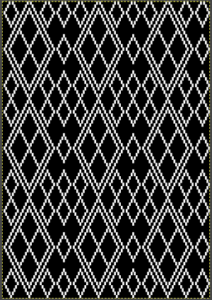 Designing your own can begin with the choice of a template, such as this one, 24 stitches by 36 rows.
Designing your own can begin with the choice of a template, such as this one, 24 stitches by 36 rows. 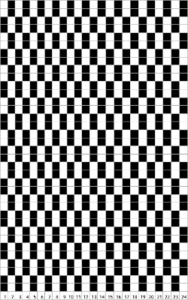 To begin with, I added a rectangle to the full template repeat on the left. To its right, the size of the rectangle then begins to be altered along with the addition of some all knit rows. The center illustrates making certain the 4 stitch repeat aligns properly at the top and bottom of the new repeat. The test final repeat image is on the right.
To begin with, I added a rectangle to the full template repeat on the left. To its right, the size of the rectangle then begins to be altered along with the addition of some all knit rows. The center illustrates making certain the 4 stitch repeat aligns properly at the top and bottom of the new repeat. The test final repeat image is on the right. 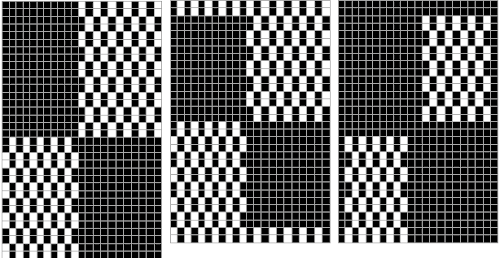 Working with a different shape, using copy and paste to place it, adding a brick variation on the right, for punchcard full repeats of 24X40
Working with a different shape, using copy and paste to place it, adding a brick variation on the right, for punchcard full repeats of 24X40
![]()
![]() The matching electronic repeats for both, unless your download requires programming for the total number of needles in use:
The matching electronic repeats for both, unless your download requires programming for the total number of needles in use:
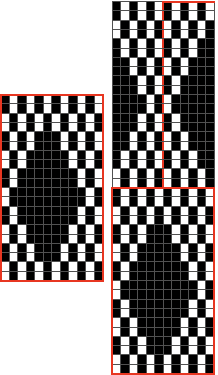 Testing tuck stitch limits, breaking the side by side white square rule in all over patterning with moving blocks of 2 by 2 blank squares
Testing tuck stitch limits, breaking the side by side white square rule in all over patterning with moving blocks of 2 by 2 blank squares 
A collection of previous posts
When more than one stitch tucks
Tuck stitch meets thread lace repeats and vice versa
Tuck lace trims (and fabrics) 2
“Crochet” meets machine knitting techniques: tuck lace trims (and fabrics 1)
Tuck and slip color striping
For those who enjoy hand techniques/slip-stitch
A no longer “mystery pattern”
A hand-knit consult
A quick review of plaiting on Brother machines
Over time plying yarns and the resulting color distribution come into question, which often leads to discussions on plaiting.
The plaited knit can be reversible, traditionally the main color will dominate the knit side, the contrast the purl.
The two yarns are threaded in separate yarn masts, with the thicker yarn on the right.
Plaiting is sometimes used in bringing scratchy yarns such as lurex can be plaited with softer yarns so that the latter is worn closer to the body in the final garment.
One of my ancient swatches shows some variations in using 2 different colored fibers in three ways. It was tagged for display with myriad other assorted swatches on corkboards in my classroom, which were usually covered with a variety of illustrations of stitches and techniques covered in weekly classes and in response to recent trends. As always, effects vary dramatically depending on the choice of yarn color, fiber content, and thickness. Here the 2 yarns were fed through separate tension masts, and knit together 
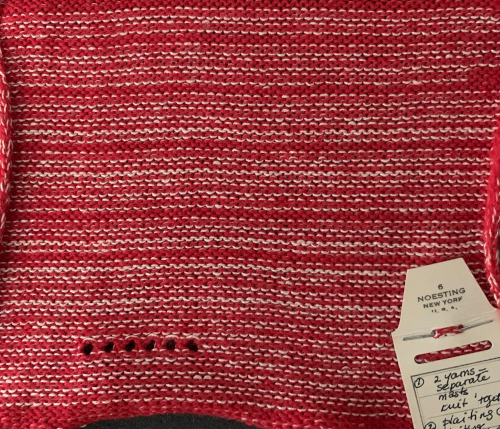 plaiting with yarns swapped in feeders for reversible striped effect
plaiting with yarns swapped in feeders for reversible striped effect 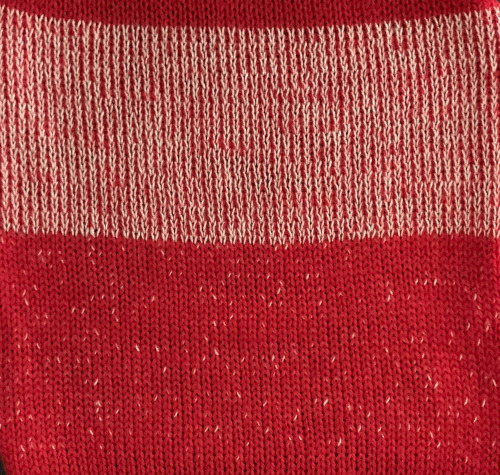
 yarns wound together with yarn twister and used as a “single strand”
yarns wound together with yarn twister and used as a “single strand” 
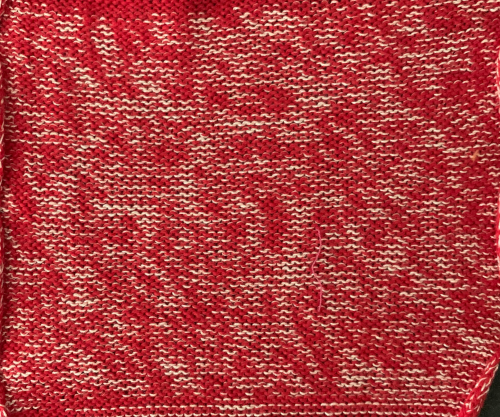 Striping created by reversing yarn positions in plaiting feeder
Striping created by reversing yarn positions in plaiting feeder 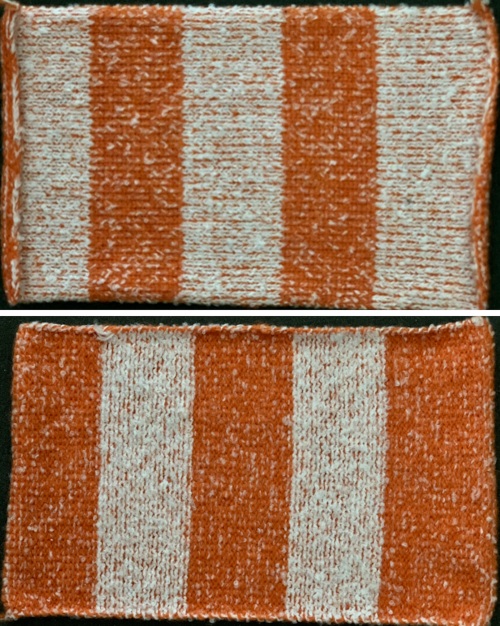 Using the thread lace setting and plaiting feeder working in every needle rib
Using the thread lace setting and plaiting feeder working in every needle rib  A mock plaiting effect may also be obtained without a special feeder by locking the pattern on any all blank row, the standard yarn feeder with A and B yarn placement, and the fair isle setting. Results are not as consistent in color distribution.
A mock plaiting effect may also be obtained without a special feeder by locking the pattern on any all blank row, the standard yarn feeder with A and B yarn placement, and the fair isle setting. Results are not as consistent in color distribution.
True plaiting usually requires a special feeder unless the specific model km has a built-in option. Two yarns are used in the plaiting feeder. They pass by the needles in sequence. One yarn always passes first, and the other follows. The standard feeder that normally carries the 2 colors when knitting fair isle is replaced, so this technique may be used in fabrics using cam button combinations other than fair isle and thread lace. Looking into the plaiting feeder from above you will see a central hole that traditionally carries the “main yarn”, and a crescent-shaped opening that carries the second yarn, which will trail behind as the carriage moves across the knitting bed. The second yarn appears on the purl side of the fabric.
On days when lurex combination scratchy yarns, and in any situation where the fiber used is unpleasant if touching the skin, a softer yarn may be used and brought to the interior side of the piece for comfort. I once made a chenille sweater with traditional cap sleeves that refused to knit to gauge. Adding matching wooly nylon and knitting it with the chenille solved the problem permanently and stabilized the knit.
The contrasting color can provide a pleasant effect when fold-over collars, cuffs, etc. are part of the garment, and so on.
Brother plaiting feeders: 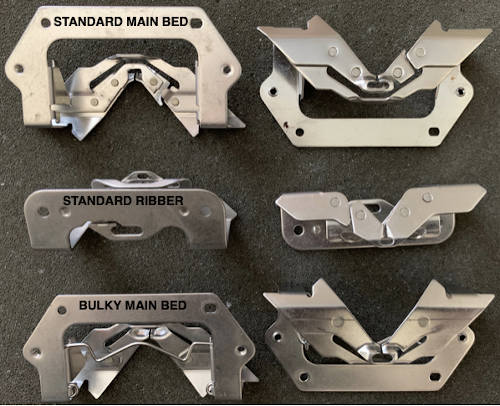 The central hole holds the main yarn and the crescent-shaped hole behind it holds the second yarn. As the carriage moves across the row, the yarn in the crescent-shaped hole trails behind the other yarn and is always the second yarn picked up by the needles, showing on the purl side of your knit.
The central hole holds the main yarn and the crescent-shaped hole behind it holds the second yarn. As the carriage moves across the row, the yarn in the crescent-shaped hole trails behind the other yarn and is always the second yarn picked up by the needles, showing on the purl side of your knit.
Be aware if considering purchasing one that other parts appear on eBay and other sale sites under this name, but are not the specific accessory. The following illustrations and directions are from Brother pubs easily found for free download.
For use on the main bed, images from the KnitKing 893 manual: 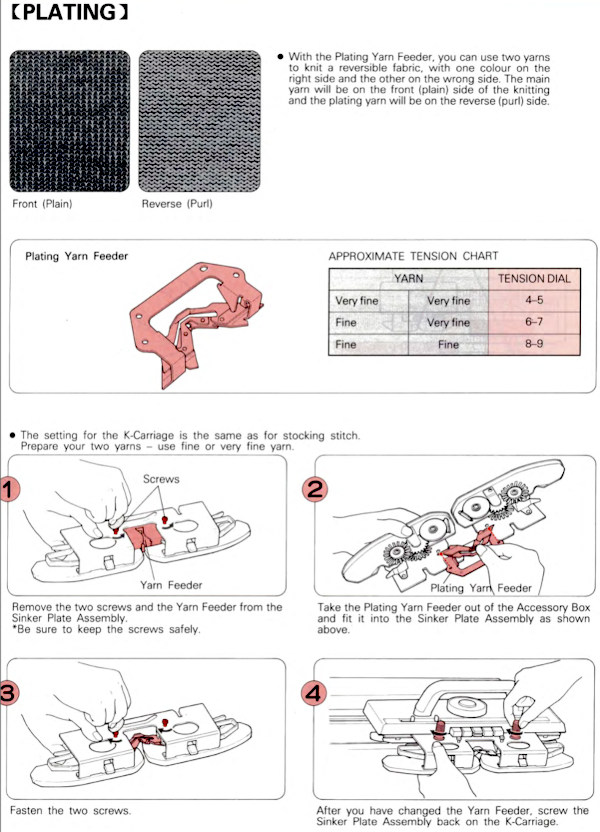

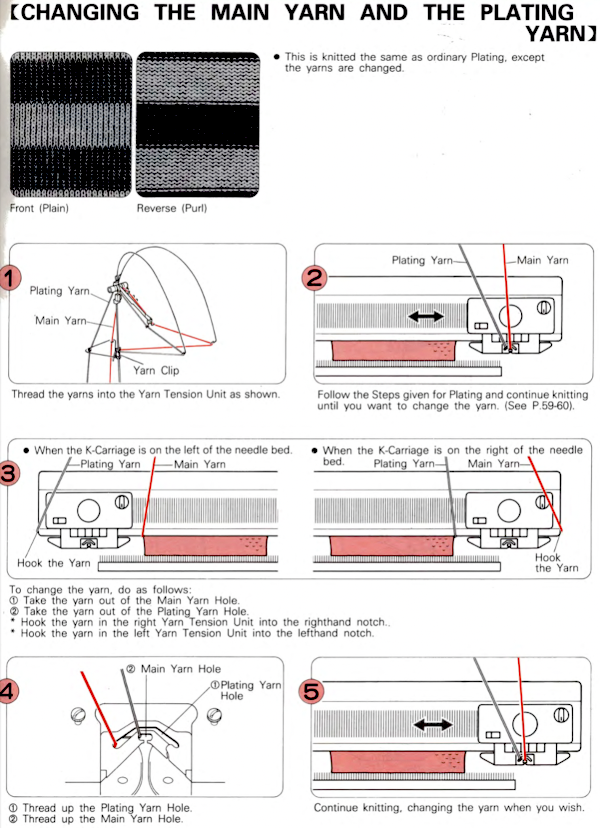
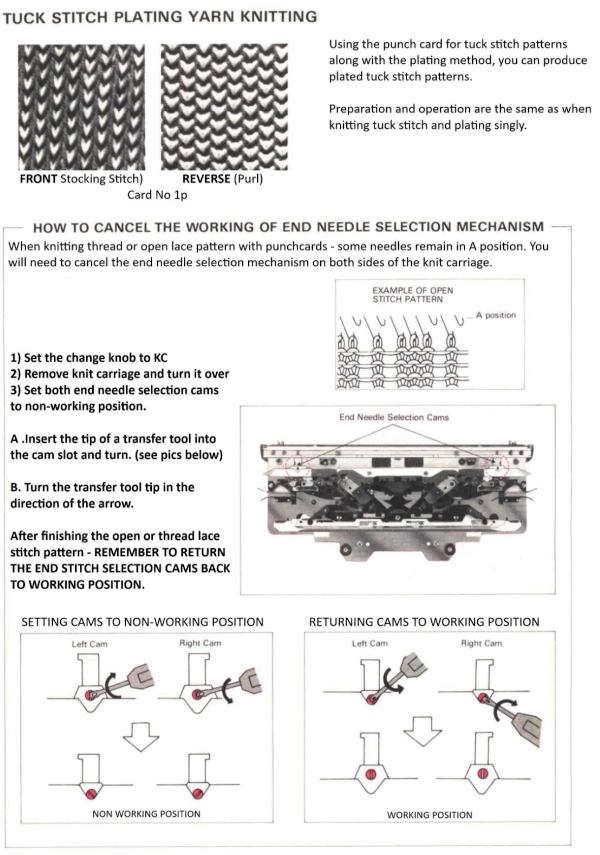 If your sinker plate has rubber wheels, check them and move them to the proper position if needed.
If your sinker plate has rubber wheels, check them and move them to the proper position if needed. 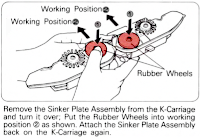 Canceling end needle selection applies in any situation and is used in tuck or slip stitch settings if there are needles out of work on the main bed for any reason to maintain proper patterning in needles in work. Electronic knitters have the KCII option in the change knob.
Canceling end needle selection applies in any situation and is used in tuck or slip stitch settings if there are needles out of work on the main bed for any reason to maintain proper patterning in needles in work. Electronic knitters have the KCII option in the change knob.
For use on the ribber:
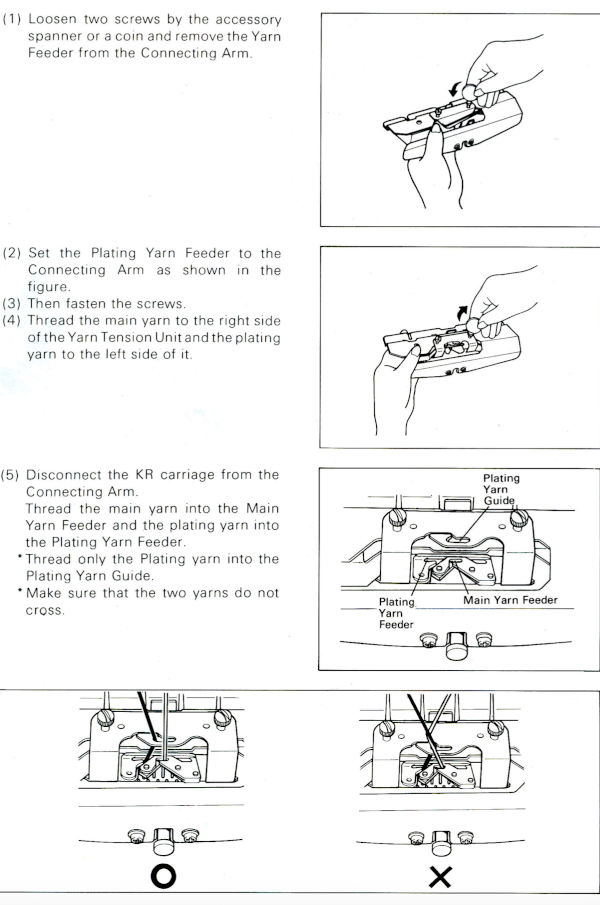
 More random, ancient swatches: stocking stitch using equal-weight yarns in a single bed tuck stitch
More random, ancient swatches: stocking stitch using equal-weight yarns in a single bed tuck stitch
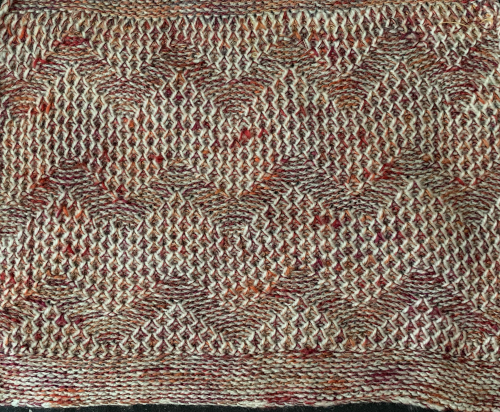
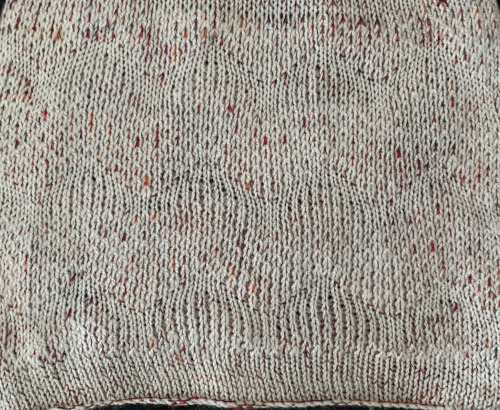 double bed every needle rib tuck stitch using the same pattern repeat
double bed every needle rib tuck stitch using the same pattern repeat 
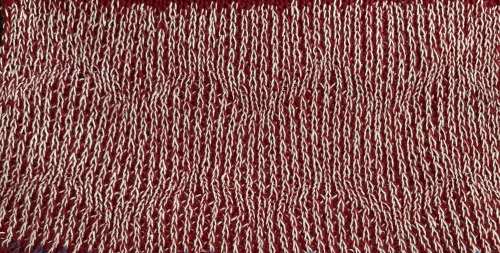 a racked sample
a racked sample 
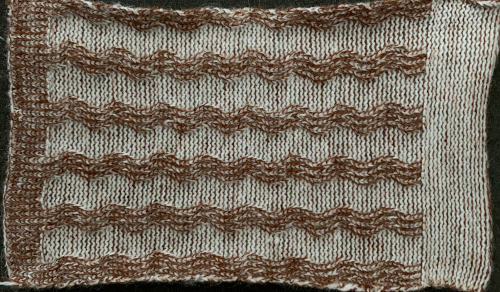 Shadow lace
Shadow lace 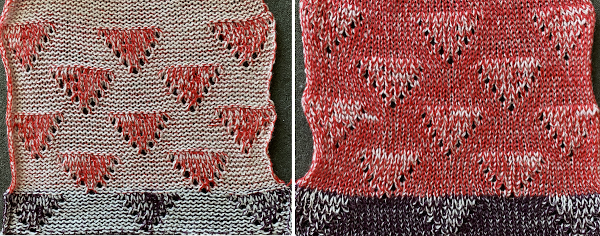 Pleated pattern
Pleated pattern 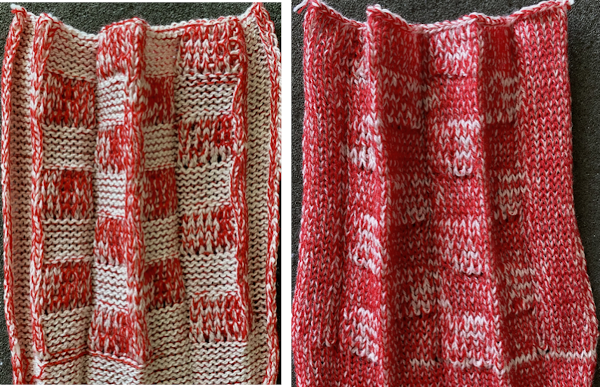 When working on large pieces, the yarn in the front feeder may slip out.
When working on large pieces, the yarn in the front feeder may slip out.
This is one option to prevent that when the ribber is in use 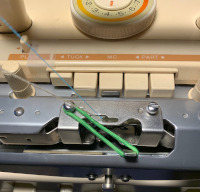 At one point, I produced several circular sweaters using equal-weight yarns to obtain the reversible 2-color look. I had more than one feeder, so I used a dab of glue in the slit below the yellow arrow
At one point, I produced several circular sweaters using equal-weight yarns to obtain the reversible 2-color look. I had more than one feeder, so I used a dab of glue in the slit below the yellow arrow 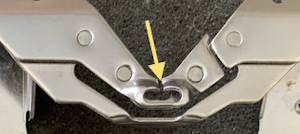 The drawback to doing that is that the yarn cannot then be easily slid in and out of its position but rather has to be dropped through the remaining hole using a double eye needle.
The drawback to doing that is that the yarn cannot then be easily slid in and out of its position but rather has to be dropped through the remaining hole using a double eye needle.
These illustrations are from a Brother manual for the 860 punchcard machine, an idea for working intarsia. I have not tested the method myself, am sharing it as a possibility for working the fabric without an accessory carriage 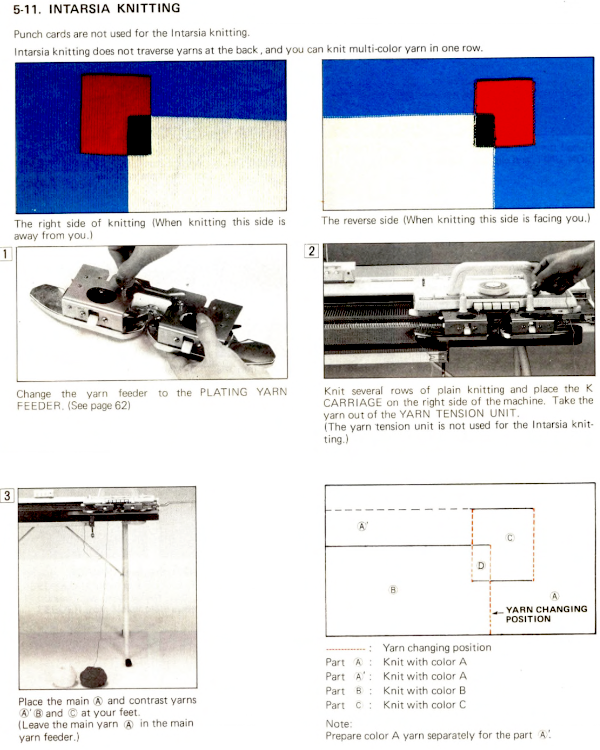

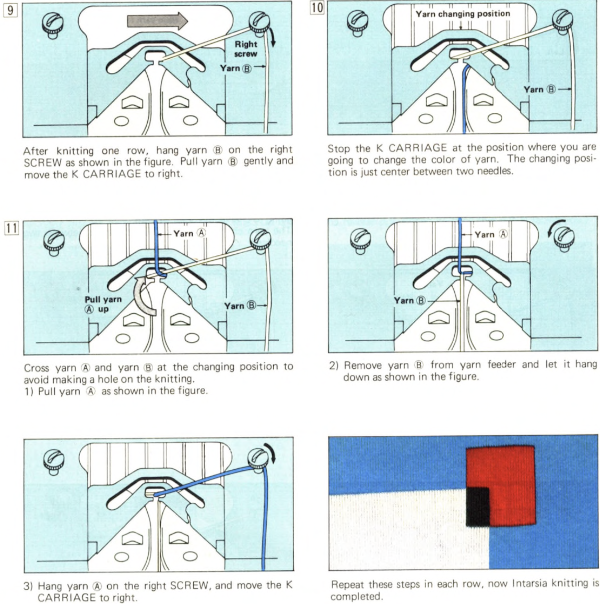 An experimental double bed fabric using the plaiting feeder and thread lace setting double bed 2015/12/05/thread-lace-and-punchcard-knit-carriage-use-on-brother-910_2/
An experimental double bed fabric using the plaiting feeder and thread lace setting double bed 2015/12/05/thread-lace-and-punchcard-knit-carriage-use-on-brother-910_2/
Ribber fabrics with stitch transfers between beds 1
These images provide partial views of garments shown in a recent Facebook MK group post, followed by the “how-to” question 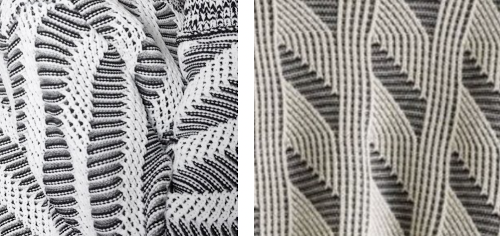 A quick analysis leads to a list of assumptions that both are double bed fabrics, with stitches subtracted or added to create moving shapes on a striped ground. A color changer will be in use, so each color must be carried for 2 passes. The color used in the traveling shapes (red in my swatches) knits on both beds, the second color creating the alternate stripe on the background knits on only one bed. The second row of the red stitches is slipped while the white knits, so they become elongated, something that is reflected on the striping on the reverse, as well as on the knit side.
A quick analysis leads to a list of assumptions that both are double bed fabrics, with stitches subtracted or added to create moving shapes on a striped ground. A color changer will be in use, so each color must be carried for 2 passes. The color used in the traveling shapes (red in my swatches) knits on both beds, the second color creating the alternate stripe on the background knits on only one bed. The second row of the red stitches is slipped while the white knits, so they become elongated, something that is reflected on the striping on the reverse, as well as on the knit side.
Though the ribber is in use, this is not a standard dbj fabric, so if automation is the goal, the color separation for the knit needs to be hand-drawn.
It is possible to move stitches to and from needle beds when knitting true DBJ with striper backing. This is one of my ancient swatches, every needle is in work on both beds except for areas where stitches have been transferred down to and up from the ribber. The main bed is set to slip in both directions, the ribber set to knit. 
 The suitable dbj separation is the one where each color in each row knits for 2 rows, whether performed by hand, using the 3 colors per row separation in img2track or the default separation in Passap. The Ayab HOP separation is awesome, works for any 3 color design with as little elongation as possible, but is not suited for this purpose. How-tos for DIY separations and their automated versions by programs for knitting more than 2 colors per row have been discussed in other posts.
The suitable dbj separation is the one where each color in each row knits for 2 rows, whether performed by hand, using the 3 colors per row separation in img2track or the default separation in Passap. The Ayab HOP separation is awesome, works for any 3 color design with as little elongation as possible, but is not suited for this purpose. How-tos for DIY separations and their automated versions by programs for knitting more than 2 colors per row have been discussed in other posts.
The process may be reversed between beds. Stitches can be picked from the opposing bed to fill in needles emptied by transfers or brought into work empty for increases. The resulting eyelets may be left as a design element or filled in by picking up from adjacent stitches or ones on the ribber bed.
In the first swatch, all stitches will be in work on the knitting bed, while patterning stitches will be in selected groups on the ribber. When testing a concept it is best to start with a simple shape, contrasting colors, on a limited number of stitches. To begin with, I went the easy route and tested the concept with a small racked pattern using only 5 ribber needles. The ribber slips for the 2 rows knit in the contrasting color in the ground, knits the pattern for 2 rows, requiring cams to be switched every 2 rows  The goal is to be able to see and understand stitch formation. Production got cut short when I was faced with dropping individual stitches followed by the whole piece falling to the floor. In one of those drat it moments I realized that for the first time ever, with the knit carriage properly set to N, I had not, however, engaged it beneath the metal bar on the back of the bed, leaving it with its rear floating freely.
The goal is to be able to see and understand stitch formation. Production got cut short when I was faced with dropping individual stitches followed by the whole piece falling to the floor. In one of those drat it moments I realized that for the first time ever, with the knit carriage properly set to N, I had not, however, engaged it beneath the metal bar on the back of the bed, leaving it with its rear floating freely. 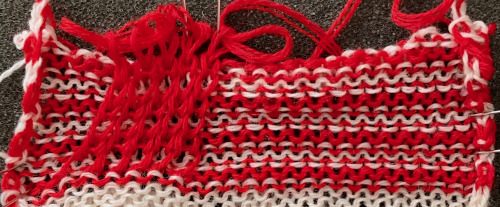 A similar process on the Passap allows for playing easily with both racked colors because of the possible arrow and pusher settings on the back bed, but on Brother, this would require hand selection on the ribber on every row or a specific color separation for needle selection on the top bed
A similar process on the Passap allows for playing easily with both racked colors because of the possible arrow and pusher settings on the back bed, but on Brother, this would require hand selection on the ribber on every row or a specific color separation for needle selection on the top bed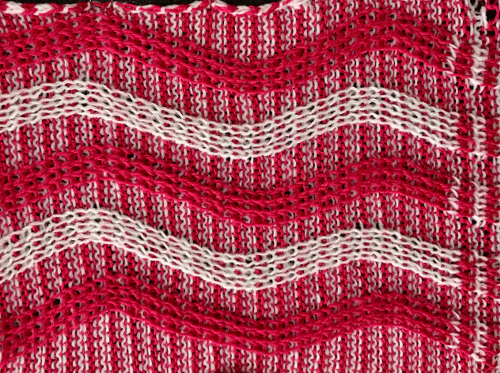 Seeking automation, keeping things simple, here is a basic zigzag pattern in a repeat also executable on punchcard machines. The ribber is now set to knit throughout (N/N), the main bed to slip in both directions. End needle selection must be canceled when using the slip setting selectively or when working patterning with needles completely out of work
Seeking automation, keeping things simple, here is a basic zigzag pattern in a repeat also executable on punchcard machines. The ribber is now set to knit throughout (N/N), the main bed to slip in both directions. End needle selection must be canceled when using the slip setting selectively or when working patterning with needles completely out of work 
The color separation: the desired design needs to be expanded, with 2 blank rows between each pair of design rows 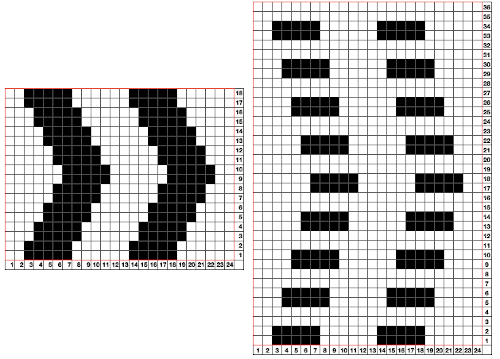 The pattern on my 930 is knit as it appears in the chart, on the purl side. Punchcard knitters or users of other programs may need to mirror it to match my output
The pattern on my 930 is knit as it appears in the chart, on the purl side. Punchcard knitters or users of other programs may need to mirror it to match my output  The process using 3 colors: the patterning color will be knit on needles preselected on the top bed. As shaping is about to begin, in this pattern, one needle preselected out indicates the location for an “increase”, one preselected back to B position a decrease
The process using 3 colors: the patterning color will be knit on needles preselected on the top bed. As shaping is about to begin, in this pattern, one needle preselected out indicates the location for an “increase”, one preselected back to B position a decrease  To perform the decrease, using a double eye tool to transfer the B position stitch down onto the ribber needle adjacent to the first needle in D position on the top bed
To perform the decrease, using a double eye tool to transfer the B position stitch down onto the ribber needle adjacent to the first needle in D position on the top bed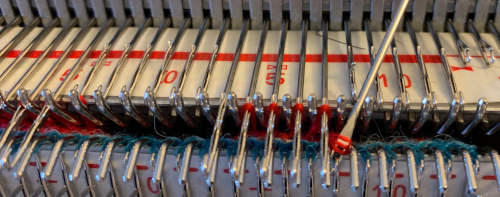
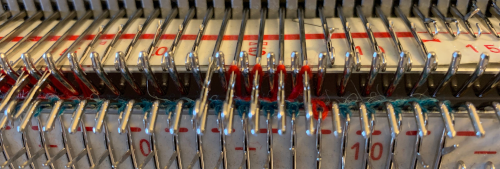 As the carriages move to the opposite side a loop will form on the preselected empty needle, creating the increase on that side, keeping the width of the patterning stitches constant
As the carriages move to the opposite side a loop will form on the preselected empty needle, creating the increase on that side, keeping the width of the patterning stitches constant  In order for the patterning to remain correct, all needles on the top bed must be maintained in B position while not in use, or preselection may be incorrect, and increase loops will not be created, so, not this
In order for the patterning to remain correct, all needles on the top bed must be maintained in B position while not in use, or preselection may be incorrect, and increase loops will not be created, so, not this  A sideways view (for space consideration) of the knit still on the KM begins to show the distortion in the knit created by the movement of the stitches. The red yarn creates a single line where stitches are skipped on the reverse, a double one when it knits for 2 rows
A sideways view (for space consideration) of the knit still on the KM begins to show the distortion in the knit created by the movement of the stitches. The red yarn creates a single line where stitches are skipped on the reverse, a double one when it knits for 2 rows 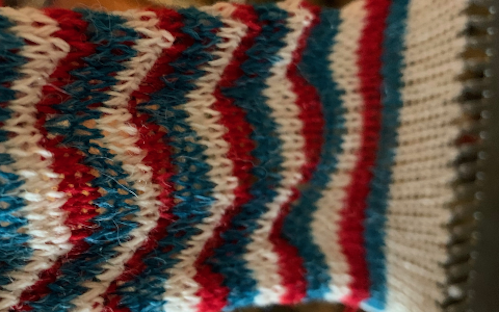 The repeat and the knit shown on both sides:
The repeat and the knit shown on both sides:  Comparing the 2 color and 3 color versions: aside from the obvious increase in length, note that the slipped segments in red on the 3 color swatch are now composed of longer stitches since they are held for 2 additional rows, and the overall fabric is more puckered than the 2 color version. The curling at the sides is the nature of edge stitches, especially if the yarn used is wool. At times that may be used intentionally, as a decorative edge.
Comparing the 2 color and 3 color versions: aside from the obvious increase in length, note that the slipped segments in red on the 3 color swatch are now composed of longer stitches since they are held for 2 additional rows, and the overall fabric is more puckered than the 2 color version. The curling at the sides is the nature of edge stitches, especially if the yarn used is wool. At times that may be used intentionally, as a decorative edge.
Repeats where the design charts require expansion to accommodate techniques quickly grow in length. The simple zig-zag doubled in length from 32 to 64 rows. I work things out in a spreadsheet, open a screengrab of the final choice in GIMP, index mode the result, scale it, and save the PNG for download to the 930. Long color separations are harder to achieve cleanly in GIMP alone but are also possible.
Returning to the 2 color pattern in the inspiration image and limiting the width to the 24 stitch punchcard restriction: a way to begin is to design a 2 color shape to approximate the repeat in the desired fabric and as in any other designs, check for repeat alignment by tiling prior to knitting to find any easily visible errors. The first single (ultimately 24X32) repeat, suitable for standard DBJ, has not been cropped properly in the top illustration. It is followed by the correct one 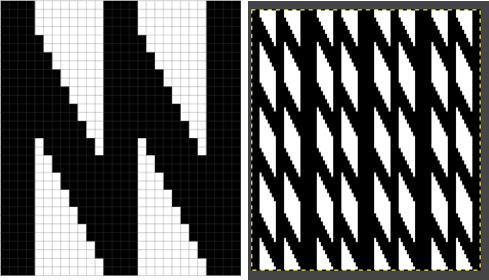
 Using the same color separation as for the simple zig-zag shape, the design is expanded to include knit bed rows that will be skipped completely, resulting in the ribber alone knitting in the second color for those rows. It is now twice as long as the original, 24X64
Using the same color separation as for the simple zig-zag shape, the design is expanded to include knit bed rows that will be skipped completely, resulting in the ribber alone knitting in the second color for those rows. It is now twice as long as the original, 24X64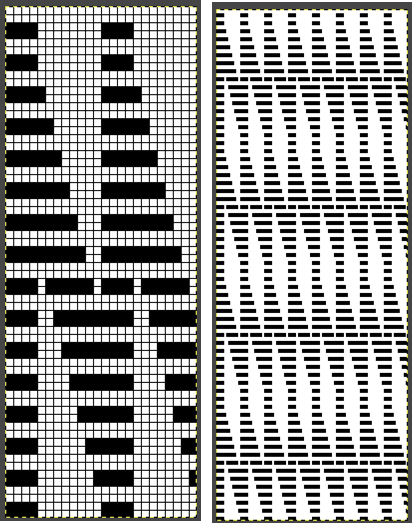 The planned proof of concept added a 4 stitch border on the right for a 28 stitch swatch centered with 14 stitches either side of 0. Tiling the repeat X2 again in height made it easier for me to plan how to manage transfers to expose the varying stripes in the ground. Visual comparison to the movement in the inspiration knit:
The planned proof of concept added a 4 stitch border on the right for a 28 stitch swatch centered with 14 stitches either side of 0. Tiling the repeat X2 again in height made it easier for me to plan how to manage transfers to expose the varying stripes in the ground. Visual comparison to the movement in the inspiration knit: 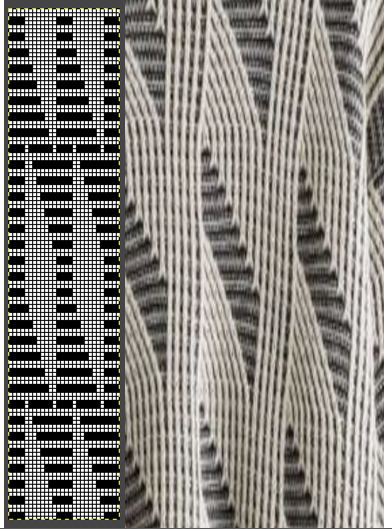 As the number of needles in work on either of the 2 beds is increased, it is likely tension or yarn changes may be required. The first preselection row is from the right, toward the color changer. The stitches on the non selected needles are transferred to the bottom bed
As the number of needles in work on either of the 2 beds is increased, it is likely tension or yarn changes may be required. The first preselection row is from the right, toward the color changer. The stitches on the non selected needles are transferred to the bottom bed 
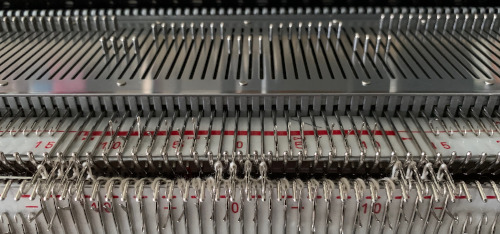 with the color change, only preselected needles will knit on both the top and bottom beds moving to the right
with the color change, only preselected needles will knit on both the top and bottom beds moving to the right 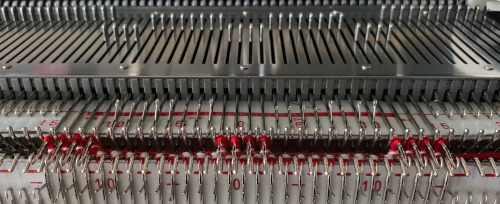 and will do so again on the return to the left while preselecting an all blank row
and will do so again on the return to the left while preselecting an all blank row 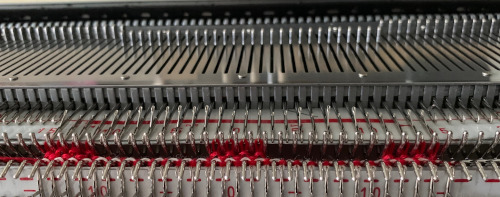 on the next pass to the right only the ribber knits in the ground color;
on the next pass to the right only the ribber knits in the ground color;  on the following pass to the left the second ground color row is knit on the ribber, with preselection happening at the same time for the next row in the pattern color
on the following pass to the left the second ground color row is knit on the ribber, with preselection happening at the same time for the next row in the pattern color 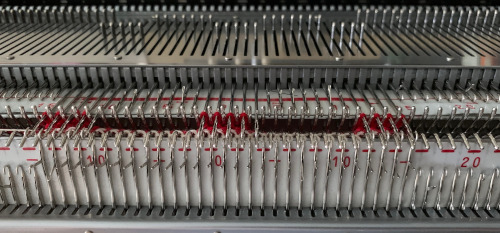 The red, 3 strand cash-wool was giving me grief, so I switched it out for the blue. Both yarns are on the thin side but OK for testing the concept. The initial partial striped lozenge shape is finished with straightforward knitting
The red, 3 strand cash-wool was giving me grief, so I switched it out for the blue. Both yarns are on the thin side but OK for testing the concept. The initial partial striped lozenge shape is finished with straightforward knitting  The solid ground stitches in the inspiration fabric, however, have a sideways movement as the next striped lozenge gets shaped. In any standard knit such movements are achieved manually by using multiple stitch transfer tools. Planning ahead in a spreadsheet helps. My first test of the full repeat approaches the desired result, but the transitions beginning at design row 30 for the decreasing angle in the white yarn is a bit clumsy and requires a redo to make it easier and with clearer instructions
The solid ground stitches in the inspiration fabric, however, have a sideways movement as the next striped lozenge gets shaped. In any standard knit such movements are achieved manually by using multiple stitch transfer tools. Planning ahead in a spreadsheet helps. My first test of the full repeat approaches the desired result, but the transitions beginning at design row 30 for the decreasing angle in the white yarn is a bit clumsy and requires a redo to make it easier and with clearer instructions 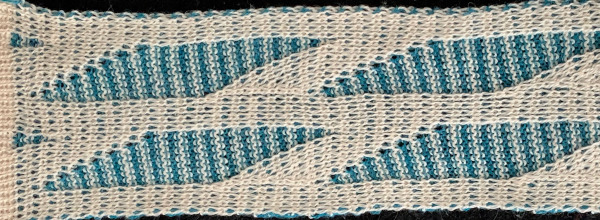 Back to the drawing board in order to reduce the number of hand manipulations involved, with a shift in the center transition, the repeat in my spreadsheet is now 24 stitches wide, plus an additional 4 stitch border, and gets marked up with colors. I prefer to program the width of my knitting as opposed to a single repeat for all over patterning
Back to the drawing board in order to reduce the number of hand manipulations involved, with a shift in the center transition, the repeat in my spreadsheet is now 24 stitches wide, plus an additional 4 stitch border, and gets marked up with colors. I prefer to program the width of my knitting as opposed to a single repeat for all over patterning 
 The resulting final 24 stitch repeat with the added 4 stitch border, now 68 rows high
The resulting final 24 stitch repeat with the added 4 stitch border, now 68 rows high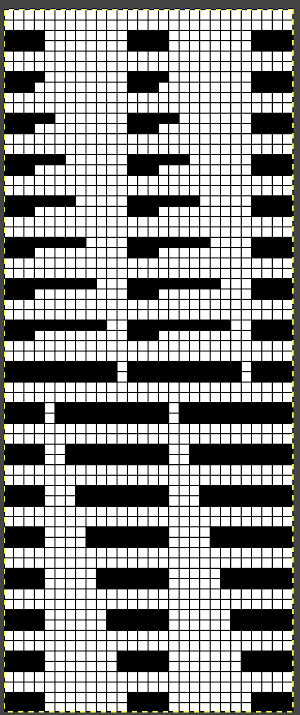 The choice can be made based upon the preference of moving stitch groups to the right or to the left with the horizontal direction of the repeat adjusted for your KM model or software used.
The choice can be made based upon the preference of moving stitch groups to the right or to the left with the horizontal direction of the repeat adjusted for your KM model or software used.  I planned the transfers in this swatch toward the color changer after picking up the proper color, white, and before knitting the next row using it. The 930 png:
I planned the transfers in this swatch toward the color changer after picking up the proper color, white, and before knitting the next row using it. The 930 png: ![]() The preselection row is from right to the left, toward the color changer. End needle selection is canceled. All stitches not selected on the main bed are moved down onto ribber needles beneath them. Needle selection takes care of the increasing angle in the surface yarn (white), as less of the striped ground becomes exposed. At this point, row 34 on the 930 counter, the single elongated slipped stitch is moved down onto the ribber.
The preselection row is from right to the left, toward the color changer. End needle selection is canceled. All stitches not selected on the main bed are moved down onto ribber needles beneath them. Needle selection takes care of the increasing angle in the surface yarn (white), as less of the striped ground becomes exposed. At this point, row 34 on the 930 counter, the single elongated slipped stitch is moved down onto the ribber. 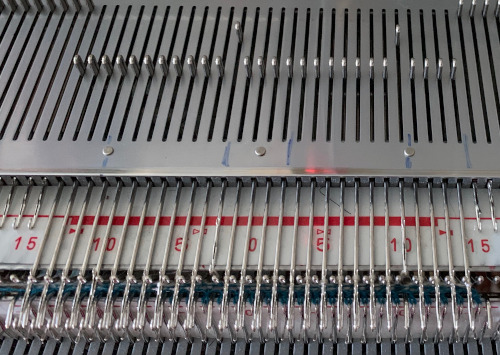 The next preselection will require the first transfer on the top bed, row 38. In my case, the movement was to the left. After the transfer is made, be certain to leave any empty needles in B position, and to bring all transferred stitch needles out to hold so they will knit in the slip setting as the carriage moves across the bed to the other side. The preselection will insure all necessary stitches will knit on the way back to the left
The next preselection will require the first transfer on the top bed, row 38. In my case, the movement was to the left. After the transfer is made, be certain to leave any empty needles in B position, and to bring all transferred stitch needles out to hold so they will knit in the slip setting as the carriage moves across the bed to the other side. The preselection will insure all necessary stitches will knit on the way back to the left  When the top of the repeat is reached, row 68, the only needles selected will be those of the 4 stitch vertical columns and the design repeat will return to its start
When the top of the repeat is reached, row 68, the only needles selected will be those of the 4 stitch vertical columns and the design repeat will return to its start
 My proof of concept swatch is 3.75 inches wide
My proof of concept swatch is 3.75 inches wide 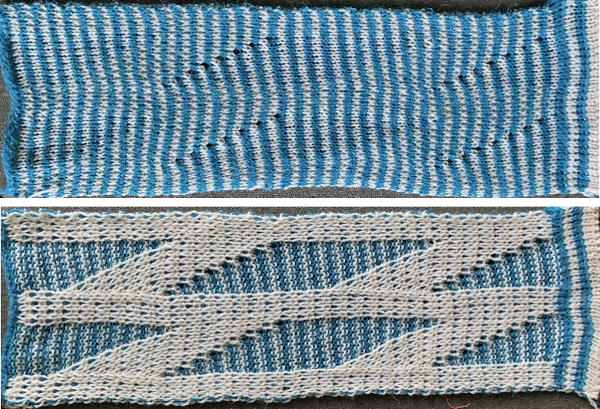 The inspiration sweater was knit using a wider repeat and significantly thicker yarn, reflected here in the small number of repeats composing the sweater body front
The inspiration sweater was knit using a wider repeat and significantly thicker yarn, reflected here in the small number of repeats composing the sweater body front  Amending the 24 stitch repeat is possible, its length will grow in proportion to the increase in its width. The ratio of rows/ stitches to maintaining shaping by single stitch increases or decreases as in the original remains at 2.8. The lozenge is likely to remain elongated. Since at any point, the ribber will be knitting a large number of stitches single bed, the tension on its carriage needs to accommodate that. When the majority of needles are selected on the top bed, the fabric is knitting in every needle rib, which requires a tighter tension than when using the same yarns single bed. As a result tension adjustment to reduce the height of the knit repeat may be very limited.
Amending the 24 stitch repeat is possible, its length will grow in proportion to the increase in its width. The ratio of rows/ stitches to maintaining shaping by single stitch increases or decreases as in the original remains at 2.8. The lozenge is likely to remain elongated. Since at any point, the ribber will be knitting a large number of stitches single bed, the tension on its carriage needs to accommodate that. When the majority of needles are selected on the top bed, the fabric is knitting in every needle rib, which requires a tighter tension than when using the same yarns single bed. As a result tension adjustment to reduce the height of the knit repeat may be very limited.
The last test is now 84 rows high, with 5 stitch vertical bands. An added 6 stitch border on one side changes the programmed width up to 36 stitches so I don’t have to think about positioning the pattern on the needle bed. The extra stitch was eliminated at the start of the piece: 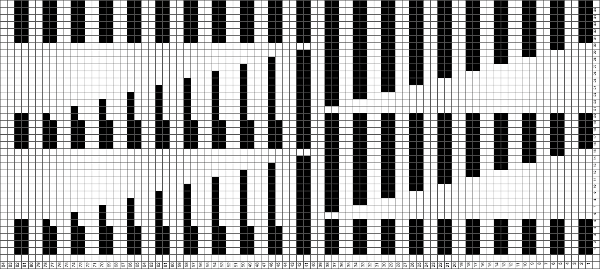 The off white yarn used here was the same thickness but not fiber content as in the previous swatch, 2/18 wool-silk vs Australian wool in the former. It is not as smoothly spun. The result shows an interesting similarity in length, though there are 16 additional rows in the pattern repeat. This time I programmed my repeat for stitch transfers on the knit bed to move away from the color changer.
The off white yarn used here was the same thickness but not fiber content as in the previous swatch, 2/18 wool-silk vs Australian wool in the former. It is not as smoothly spun. The result shows an interesting similarity in length, though there are 16 additional rows in the pattern repeat. This time I programmed my repeat for stitch transfers on the knit bed to move away from the color changer.  Eliminating the border on one side, a double repeat (30 stitches) measure 4 inches in width. To put the difference in scale to the sweater in perspective, an oversize garment with 40 inches in chest diameter would require 20 inches in width for the front piece. Ten single repeats, as opposed to the inspiration’s sweater 4, bring the total required the number of stitches to 150. With the added border of 5 stitches for matching side edges, the fabric is in the realm of possibility for producing a garment on the home knitting machine. My tension was set at 3/3 for all the swatches, with some teasing required on occasion to encourage stitches on the main bed to knit off properly. Ribber height adjustment can also have an effect on those numbers. I tend to do all my knitting with the slide lever in the center position. The double 30X84 repeat with no added border
Eliminating the border on one side, a double repeat (30 stitches) measure 4 inches in width. To put the difference in scale to the sweater in perspective, an oversize garment with 40 inches in chest diameter would require 20 inches in width for the front piece. Ten single repeats, as opposed to the inspiration’s sweater 4, bring the total required the number of stitches to 150. With the added border of 5 stitches for matching side edges, the fabric is in the realm of possibility for producing a garment on the home knitting machine. My tension was set at 3/3 for all the swatches, with some teasing required on occasion to encourage stitches on the main bed to knit off properly. Ribber height adjustment can also have an effect on those numbers. I tend to do all my knitting with the slide lever in the center position. The double 30X84 repeat with no added border![]()
A return to Ayab knitting
9/18/21 There have recently been efforts to provide the Stitchworld I files for easy download for electronic knitting. The file is in progress, the work of Thomas Price, it may be found at https://github.com/t0mpr1c3/ayab-patterns/tree/master/kh930. Click on the main folder “ayab. patterns” and then click on the green button at the right top of the page (code)
My starting document for subdivisions into categories: Ayab patterns.numbers
and as a PDF Ayab patterns.
Folks without access to the Github can find similar collections of electronic repeats on KnitStudium.com
I have been asked specifically about the difference between Lace and Fine lace. Fine lace is created by changing the setting on the lace carriage between N and L whether for a whole piece or between the 2 settings on combination fabrics. Instead of being transferred from one needle to another, when the F setting is used, the single stitch is shared between two needles.  The standard lace transfer
The standard lace transfer
 Depending on the yarn and tension, far smaller eyelets may still appear. In my opinion, fine lace fabrics have a texture that is so “fine” that unless one is using a light shade of yarn with a smooth twist that highlights the changes in the surface of the knit the resulting texture may be hard to recognize. The combination fabrics have both eyelets and surface textures.
Depending on the yarn and tension, far smaller eyelets may still appear. In my opinion, fine lace fabrics have a texture that is so “fine” that unless one is using a light shade of yarn with a smooth twist that highlights the changes in the surface of the knit the resulting texture may be hard to recognize. The combination fabrics have both eyelets and surface textures. 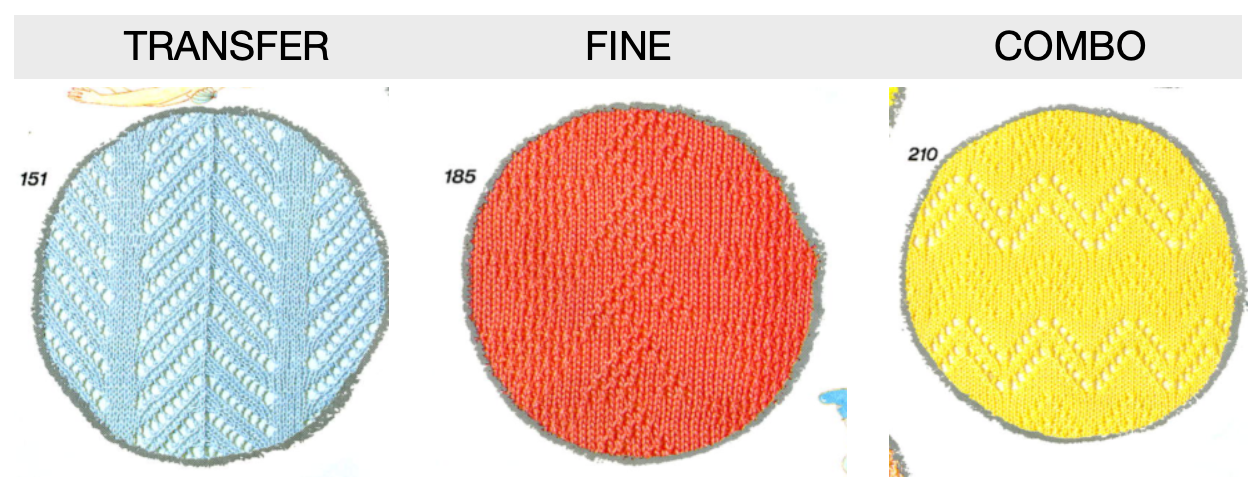
Fabrics using the word lace in their name may not necessarily use the lace carriage or result in the familiar LC transfer eyelets
Tuck and lace: LC transfers combined with tuck stitch patterning
Woven lace: LC transfer lace combined with the weaving technique
Lace and fair isle: LC and FI patterning, both carriages selecting needles
“Lace-like patterns”: possible in machines such as Brother and Passap, which allow for the same stitches tucking in one direction, slipping on the return of the knit carriage to its starting side. It matters which cam button function leads in the start of each pattern
Punch/ thread lace: thick and thin yarns used together in machines that have the option of a setting that allows for knitting both yarns together in unpunched areas or blank pixel rows, with traditionally, the thin yarn knitting in the front of the fabric, the thicker floating behind it
Tuck lace: tuck setting in both directions with specific needles out of work
Ladder Lace: worked with columns created by needles left out of work
Punch tuck rib: every needle rib combined with tuck setting patterning on the knit bed Drive/ drop stitch lace: stitches start on either of the 2 beds, and loops are picked up and dropped on the opposite bed
Shadow lace: stitches are moved between beds in a pattern to create knit stitches on purl ground or vice versa
Repeats can be used in multiple cam settings:
Fair Isle repeats with short floats may often be used in other stitch settings
Though listed in the FI section, 3 A, B, and C are knit as tuck stitches with needles out of work, NOOW
Any patterns with large floats ie 6 -8 are best knit as DBJ, double bed, ribber setting
In patterns such as #43, the left-hand column lists numbers 2, 3, and 4 indicating color changes in the B feeder, while maintaining a constant color ground in the A feeder
Any single motif pattern may be used for DBJ if programmed accordingly
Many FI may work well when programmed with the G carriage.
Transfer lace, fine lace, and combinations of both are used exclusively for that fabrics.
Tuck patterns are safe to try with every cam setting, though the resulting knit may not be exciting. Most containing single or double rows of white squares may be knit double-long for more texture.  If the tucks occur for 2 or 4 rows, with a color changer it becomes easy to change colors every 2 or 4 rows respectively, and patterns with many white cells may result in a knit that looks like what is often referred to as mazes or mosaics.
If the tucks occur for 2 or 4 rows, with a color changer it becomes easy to change colors every 2 or 4 rows respectively, and patterns with many white cells may result in a knit that looks like what is often referred to as mazes or mosaics.
Three tuck rows such as in 236 and 248 would only tolerate elongation if a very fine yarn is in use. Color changes would result in elongated stitches being knit off on stripes in the alternating color, a less often used method than having them knit off on the next same color stripe. Any tuck repeat may also be knit using the slip stitch setting, but while tuck fabrics are usually considered reversible, the slip stitch purl side may be far less interesting.
Tuck repeats 283-292 rely on the correct needles being taken out of work to produce a fabric known as tuck lace. Depending on the machine model, the repeat may have to be flipped horizontally to set up proper NOOW for successful patterning.
Slip stitch settings with all-over pixel units matching those illustrated for tuck may be used in the tuck setting as well, ones with small areas of black cells may also work in weaving. Taking floats into consideration, repeats with rows with no more than 5 continuous black squares may work for Fair Isle.
When using tuck or slip patterns for FI, color reverse the image so the patterning of the white cells occurs in the B feeder and any color changes other than in the ground may be more easily made.
Patterns that look scrambled to the eye are usually intended for use with the color changer and again are accompanied by suggestions for color rotations made in the far left-hand column of the repeat ie in # 386 and 392 where the slip setting is used. The same patterns may be knit double bed, but any fabric changing color every 2 rows needs the first preselection row for row 1 to happen from the right, so adjustments need to be made when using such repeats in Ayab.
Thread lace patterns are best left for thread lace.
Hooked-up floats such as in patterns 408 – 413 use the technique to achieve added patterning on the purl side.
Some weaving patterns ie 427, 432, and 440 could be used for tuck or slip as well. Using repeats in other settings becomes easier when one recognized a few “rules”. Hooked-up floats appear here as well, ie 460, and variations on e-wraps ie 463
As presented the garter carriage patterns do not translate well for other techniques without manipulation ie color reverse or more.
Patterns in the series KHC 512-521 are intended for use with the single bed color changer to produce the striped color patterning, the first preselection row is assumed to happen from the right.
Patterns in the series KRC 522-531 are intended for use with the double bed color changer. The first preselection row is from left to right.
Both sets indicate color changes in columns on the far left of the illustrations.
The remaining patterns are also intended for use with the G carriage.
1/2021 For a variety of reasons it has been nearly a year since I attempted any swatch tests in significant lengths using Ayab. I am interested in exploring long repeats created with small stitch units, and the possible illusion of color variations if any created by the fabric movement. My first design was a dbj heart of Pluto fail because of a problem between the monitor and the chair, the middle value was too close to one of the 2 other colors in the palette, so it did not get knit on the top bed, I did not pay attention, kept on going, the patterning for only 2 colors appeared correct over more than 200 rows. The second test was of a different repeat in 2 colors. It was knit in single bed FI for the first run and here I am again with the issue I have had in the past with patterning errors in longer knit pieces. The fabric begins to do what I intended, the effect may be more marked if knit at a tighter tension. This is the working repeat, 34 X140 pixels, check if downloaded that the mode does not get switched back to RBC,
This is the working repeat, 34 X140 pixels, check if downloaded that the mode does not get switched back to RBC, ![]() here repeated X2 in width, with a 2 stitch border in black on either side (72 X 140), suitable width for a scarf in DBJ. DBJ is a better choice for long pieces since fair isle has a tendency to not stay flat, rolling toward the purl side. The side border is a personal preference of mine. Now that Ayab allows for repeating the patterns both in width and height, such border additions, whether for a single color vertical line or to produce all knit stitches aside tuck or slip center areas are still not possible additions within the program itself
here repeated X2 in width, with a 2 stitch border in black on either side (72 X 140), suitable width for a scarf in DBJ. DBJ is a better choice for long pieces since fair isle has a tendency to not stay flat, rolling toward the purl side. The side border is a personal preference of mine. Now that Ayab allows for repeating the patterns both in width and height, such border additions, whether for a single color vertical line or to produce all knit stitches aside tuck or slip center areas are still not possible additions within the program itself  There have previous posts on automated lace edging on Brother machines, ie 1, and 2. For anyone wishing to try them, this shows the proper Ayab orientation for the repeat, along with selection errors on my 910
There have previous posts on automated lace edging on Brother machines, ie 1, and 2. For anyone wishing to try them, this shows the proper Ayab orientation for the repeat, along with selection errors on my 910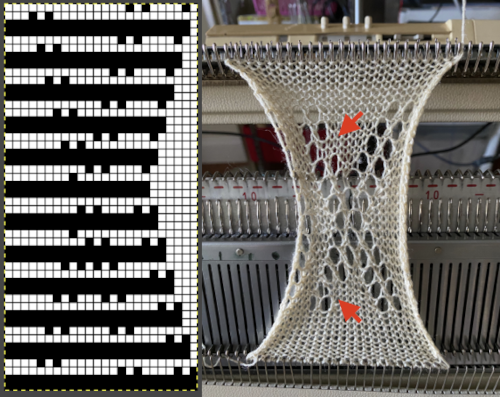 The first preselection row is as always from left to right, the knit carriage, set to slip in both directions when on the right knits 2 rows, preselects for the first row of transfers as it moves from left to right, and lace patterning and selection begins from the opposite side. Extension rails are a must on both sides since both carriages are now selecting needles and each needs to be off the belt while the opposite carriage is in use
The first preselection row is as always from left to right, the knit carriage, set to slip in both directions when on the right knits 2 rows, preselects for the first row of transfers as it moves from left to right, and lace patterning and selection begins from the opposite side. Extension rails are a must on both sides since both carriages are now selecting needles and each needs to be off the belt while the opposite carriage is in use
After absences from topics, I find it necessary to review them and their categories. This list, for now, catalogs my previous shares on Ayab use specifically, all are subject to future editing
Revisiting Ayab_multiple colors per row DBJ 1/20
Ayab: short rows automated with slipstitch 5/18
Revisiting knitting with 2 carriages single bed, 910 vs Ayab so far 4/18
A Brother 910/ Ayab diary/ EMS kit 3/18
Quilting using Ayab software 2/18
Drop stitch lace using Ayab software 1/18
Lace punchcards meet Ayab 1/18
Although my swatches this past year were often knit using another interface I have added mentions of ayab repeats which will turn up in searches. Other times I have added them to earlier posts such as this one combining KC patterning with racking 2017/12/20
Some studio electronic patterns translated for use on Brother KMs
Each machine brand varied control box symbols over the years, and at times cam options also evolved. My long since Studio electronic experience was using the 560. The image below was from a pattern book for a later model. I first included them in a post on knitting with elastic  Identifying stitch types in Japanese symbols in decoding patterns and charts can be confusing. Some large type illustrations extracted from punchcard pattern books may be found in my post on knit terms and translations
Identifying stitch types in Japanese symbols in decoding patterns and charts can be confusing. Some large type illustrations extracted from punchcard pattern books may be found in my post on knit terms and translations  The Studio cam settings
The Studio cam settings  The 580 operation manual explains those ducks and the function of point cams
The 580 operation manual explains those ducks and the function of point cams
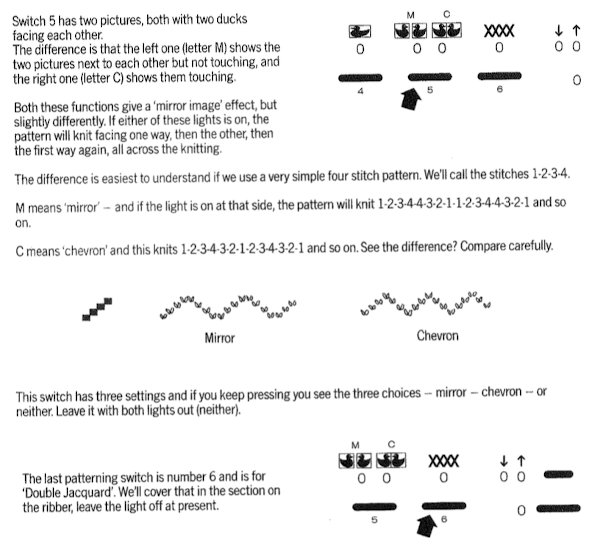
The stitch type is fair isle, also indicated by the recommendation in English of colored yarns, one combined with elastic, being held in 2 different feeders 


Adding a border on the left side by positioning

Mirror and combing the 2 patterns into one, center on the needle bed, the left duck symbol on means the pattern knits as you see it, and it is mirrored as the ducks are pointing 
 25: the original provided was 60X24, here it is adjusted to a full size 76X24
25: the original provided was 60X24, here it is adjusted to a full size 76X24![]()
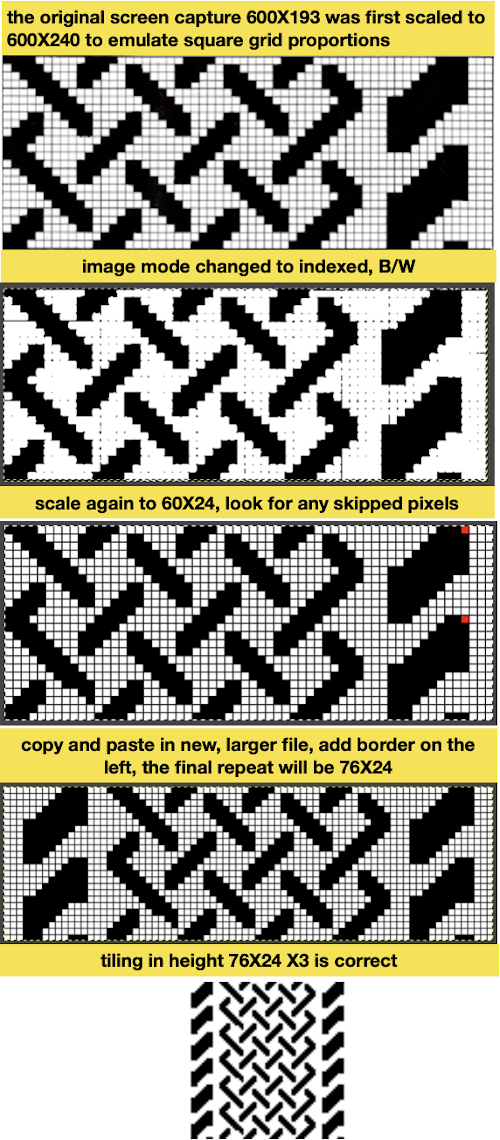
27: the repeat provided was 60X48, here it is adjusted to a full size 120X48 ![]()
 28: the repeat provided was 60X84, here it is adjusted to a full size 120X84
28: the repeat provided was 60X84, here it is adjusted to a full size 120X84
 tiled X2 in height to check for proper alignment
tiled X2 in height to check for proper alignment 
Knitting with “unusual” fibers/ elastic 2
My first DBJ tests from a previous post on knitting with elastic. used an axometric shape, with the tentative repeat worked out and in turn, elongated X2 and tiled to check alignment.![]()
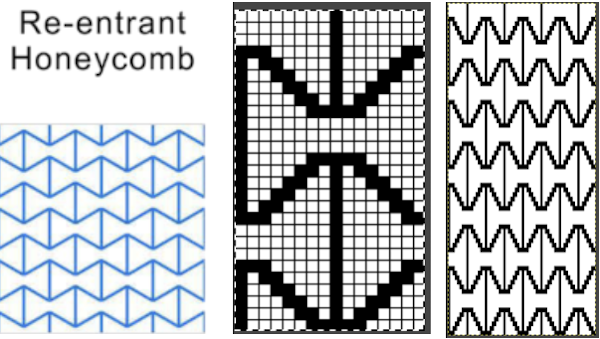 Until doubled in height the original repeat is composed of an odd number of rows in height. Usually, double bed knitting relying on color changes or automatic DBJ KRC separations require an even number of rows in the motif. The first sample was knit using single-ply cotton and elastic yarns respectively, fed through separate upper tension disks but knit together as a single color. The swatch is 72 stitches in width but measures only 14.5 mm (5.7 inches) in width, producing a gauge of nearly 13 stitches for inch, not achievable when knitting with standard fibers on a standard 4.5 mm machine. The pattern is subtle, more visible on the knit side, hard to tell there are pockets in the knit. The cotton is space-dyed, and as true when using such yarns, that causes some confusion in immediately identifying a clear pattern. The ruffled effect is simply from a plain knit start and color-changing stripes to test tension and knittability on the planned needle width. Machine settings: opposite part buttons, no lili
Until doubled in height the original repeat is composed of an odd number of rows in height. Usually, double bed knitting relying on color changes or automatic DBJ KRC separations require an even number of rows in the motif. The first sample was knit using single-ply cotton and elastic yarns respectively, fed through separate upper tension disks but knit together as a single color. The swatch is 72 stitches in width but measures only 14.5 mm (5.7 inches) in width, producing a gauge of nearly 13 stitches for inch, not achievable when knitting with standard fibers on a standard 4.5 mm machine. The pattern is subtle, more visible on the knit side, hard to tell there are pockets in the knit. The cotton is space-dyed, and as true when using such yarns, that causes some confusion in immediately identifying a clear pattern. The ruffled effect is simply from a plain knit start and color-changing stripes to test tension and knittability on the planned needle width. Machine settings: opposite part buttons, no lili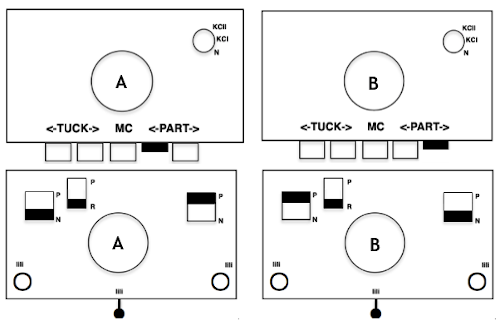
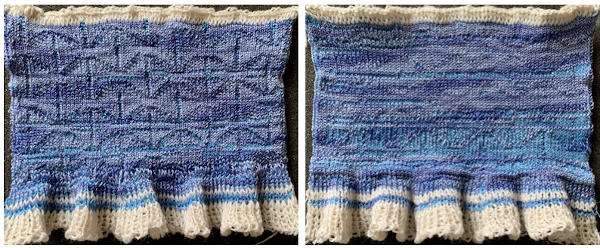 Here the same pattern was executed on the same number of stitches with the white wool used above, but the elastic was plied with a 2/24 acrylic yarn and knit as DBJ with the blue, stretchy combination creating the solid color backing.
Here the same pattern was executed on the same number of stitches with the white wool used above, but the elastic was plied with a 2/24 acrylic yarn and knit as DBJ with the blue, stretchy combination creating the solid color backing.  A comparison in scale
A comparison in scale 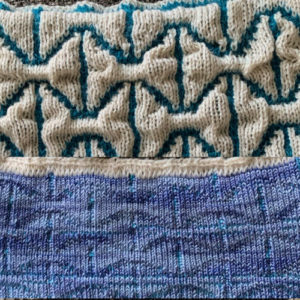 The same pattern repeat knit with striper backing is far less interesting
The same pattern repeat knit with striper backing is far less interesting 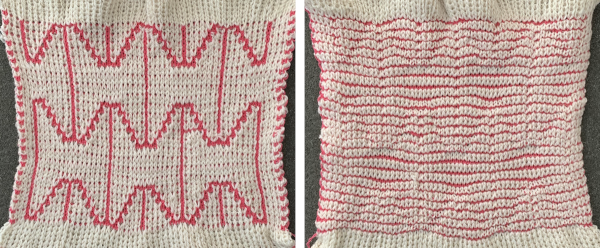
The solid color backing in DBJ can be produced by changing ribber settings with each color change from N/N to slip <– –> and back. I have sometimes knit DBJ with 4 carriages or with a third, knit-only carriage working the rows normally slipped by the ribber. The sinker plate for one knit carriage is altered as described in the post. The knitting requires that the ribber stops be removed, and that carriage(s) be off the bed on extension rails while the other(s) are in use so as not to damage the belt. The maximum width of the fabric is limited by the necessity of having the knit cleared on both sides with all carriage passes.
My mongrel setup includes a 930 bed, an 892 punchcard carriage with a magnet attached coupled with the 850 ribber carriage, and a 910 carriage with the modified sinker plate. As a bit of possible disaster prevention, the knit/ribber combo has an elastic to ensure the ribber stays on its own bed as well, while I grabbed extras to help support the rail on the other side just in case the 910 carriage went too far. 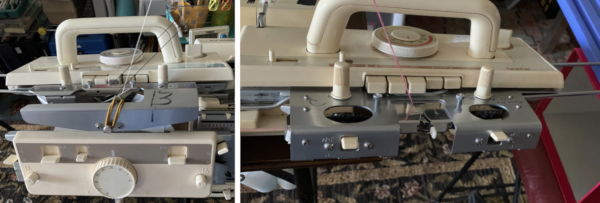 Because when using the KRC separation the white squares knit first, I planned the repeat for 64 stitches color reversing the repeat used the FI and thread lace samples in the previous post.
Because when using the KRC separation the white squares knit first, I planned the repeat for 64 stitches color reversing the repeat used the FI and thread lace samples in the previous post.![]() to this,
to this,  I used a 2/18 wool at tensions 3/3 for the backing fabric and two strands of the elastic with no added changes to its yarn mast tension, at tension 7 in the single knit carriage.
I used a 2/18 wool at tensions 3/3 for the backing fabric and two strands of the elastic with no added changes to its yarn mast tension, at tension 7 in the single knit carriage.
Using this method of DBJ, which is the same as that used in 2 color quilting, when the ribber and knit carriage both knit, the fabric is sealed where there are needles selected on the main bed. When the ribber is set to slip in both directions, or the method here is used, the main bed only knits selected needles and skips the nonselected ones, creating floats and pockets in the fabric in those areas. 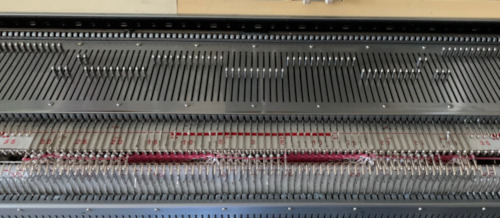
 The appearance of the fabric when stretched and weighted, still between the beds
The appearance of the fabric when stretched and weighted, still between the beds 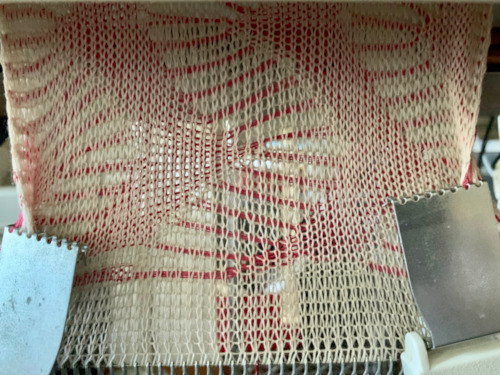 and off
and off  Going the far more traditional route of traditional dbj with the use of the color changer, striper backing with the ribber set to N/N yields a wider, flatter fabric with an interesting purl side
Going the far more traditional route of traditional dbj with the use of the color changer, striper backing with the ribber set to N/N yields a wider, flatter fabric with an interesting purl side  while my very brief effort at attempting to knit with one side of the ribber set to knit, the other to slip, met with immediate dropped stitches by the elastic.
while my very brief effort at attempting to knit with one side of the ribber set to knit, the other to slip, met with immediate dropped stitches by the elastic.  The birdseye version had more of a bent on
The birdseye version had more of a bent on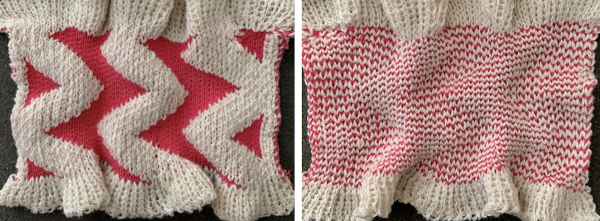 the surfaces of both colors. I stopped knitting when a few of the elastic stitches on the left purl side dropped off. It would appear at this point that the most interesting effects in the simplest to execute DBJ setting are ones with balanced positive and negative spaces in the design.
the surfaces of both colors. I stopped knitting when a few of the elastic stitches on the left purl side dropped off. It would appear at this point that the most interesting effects in the simplest to execute DBJ setting are ones with balanced positive and negative spaces in the design.
Previously I used the repeat on the top left, also shown tiled. The subsequent swatch was knit using the bottom 66X22 tiled repeat, planning to start KRC preselection from the left on a white square, the ribber set to N/N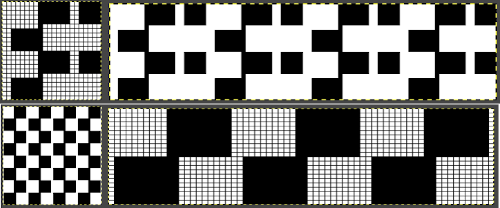
![]() I found the fabric attractive on the purl side, but I was having issues with dropped stitches I could not explain that would need sorting out if producing larger swatches.
I found the fabric attractive on the purl side, but I was having issues with dropped stitches I could not explain that would need sorting out if producing larger swatches. 
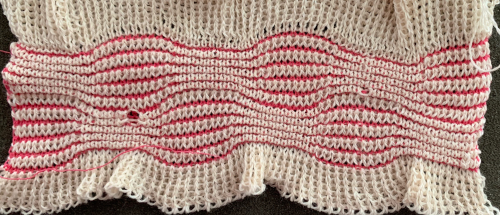 Adding a third ply of elastic was disastrous at any tension. Better results occurred simply by increasing the ribber tension by 2 whole numbers, the knit tension by 1, and reverting to the previous yarn usage. There is a single dropped stitch in the elastic, and the result has much more of a 3D effect.
Adding a third ply of elastic was disastrous at any tension. Better results occurred simply by increasing the ribber tension by 2 whole numbers, the knit tension by 1, and reverting to the previous yarn usage. There is a single dropped stitch in the elastic, and the result has much more of a 3D effect. 

